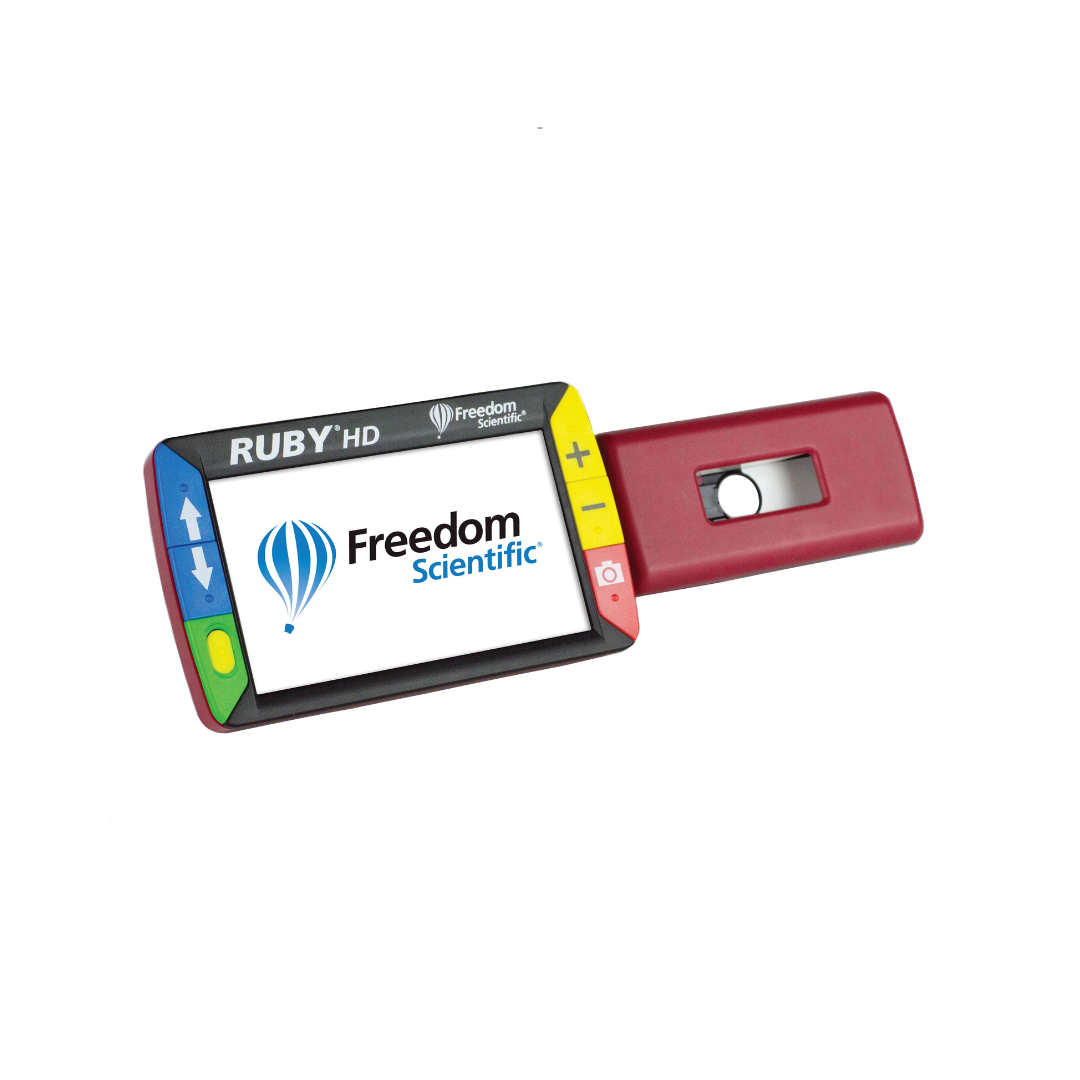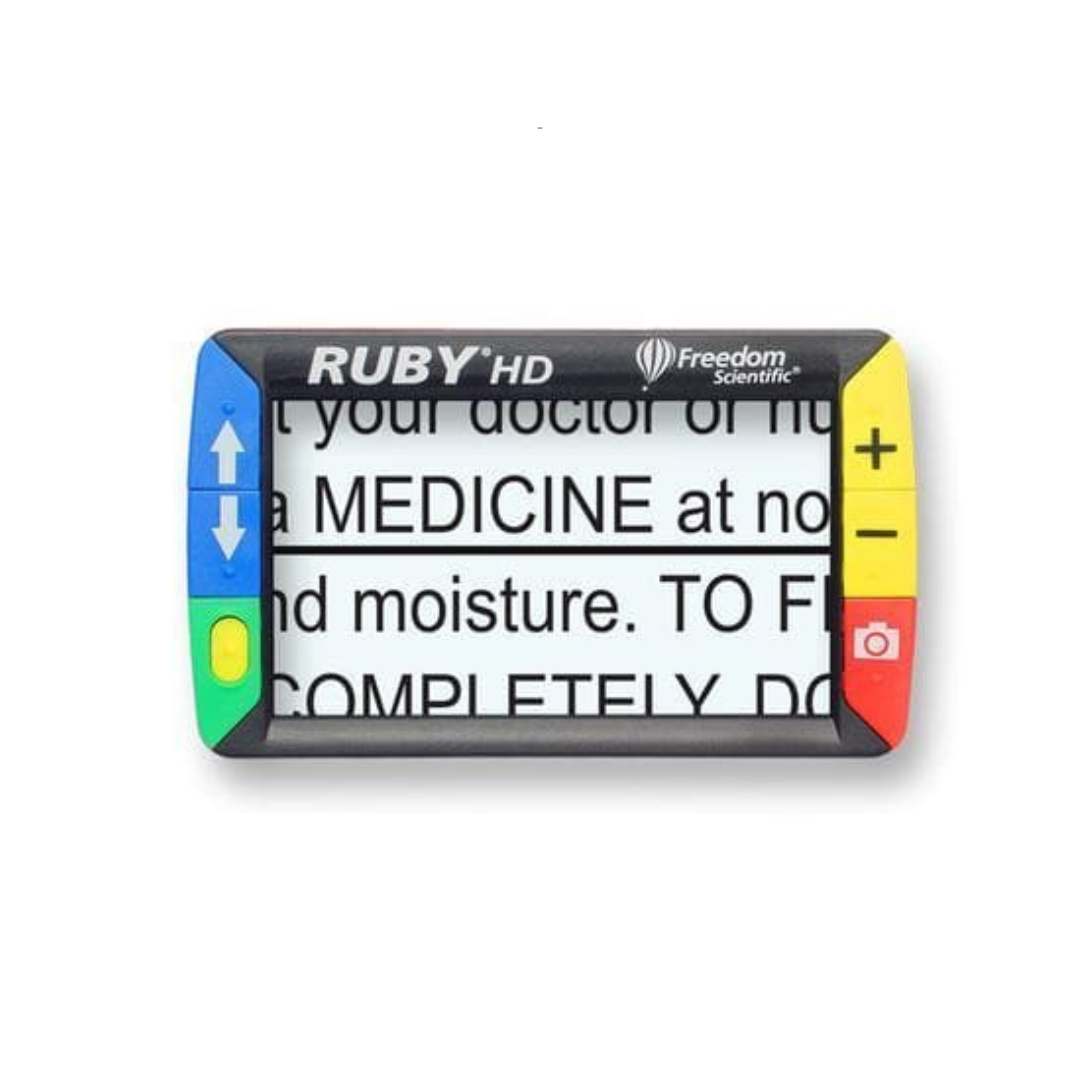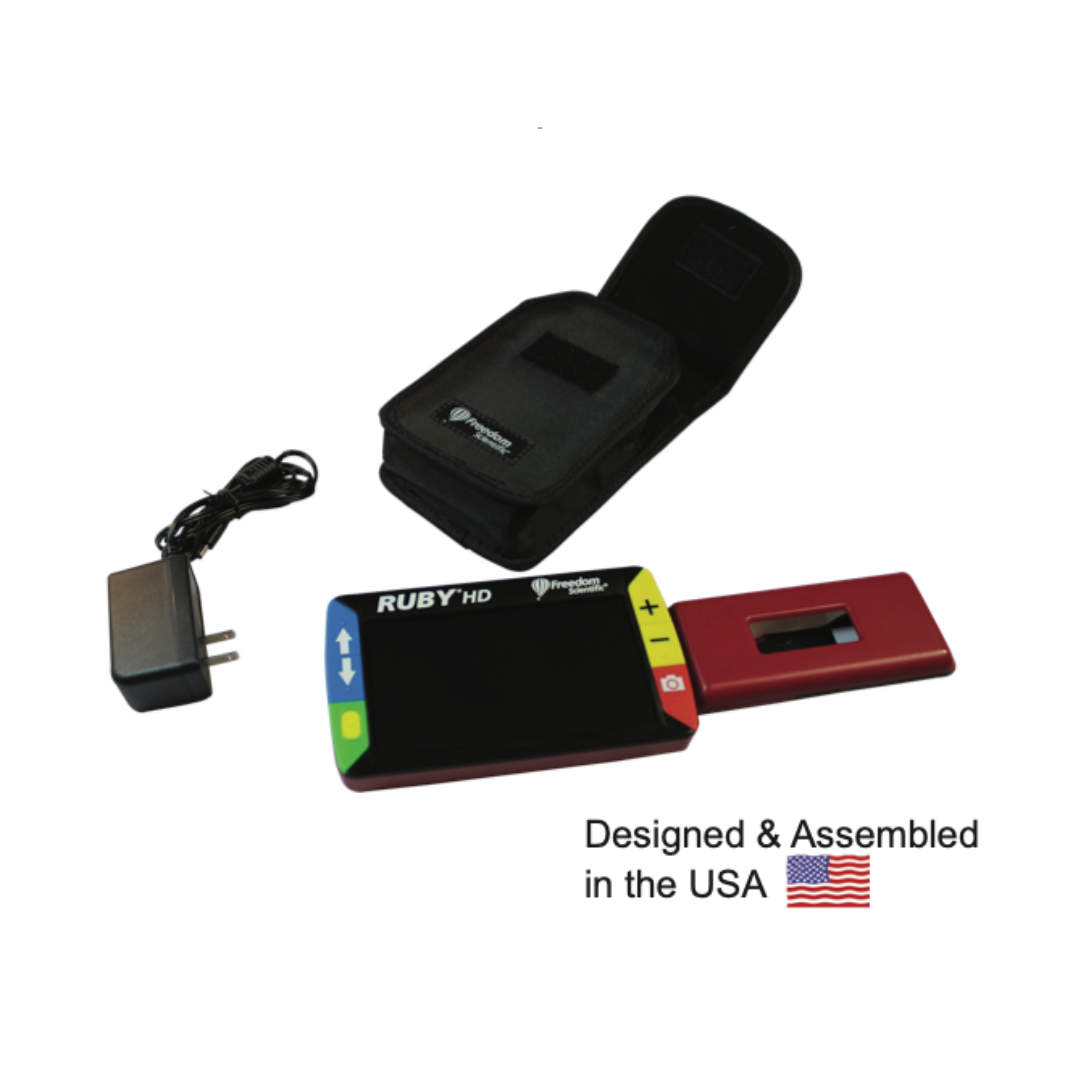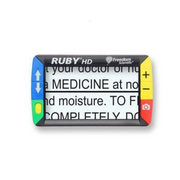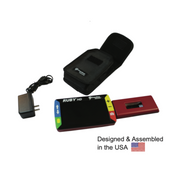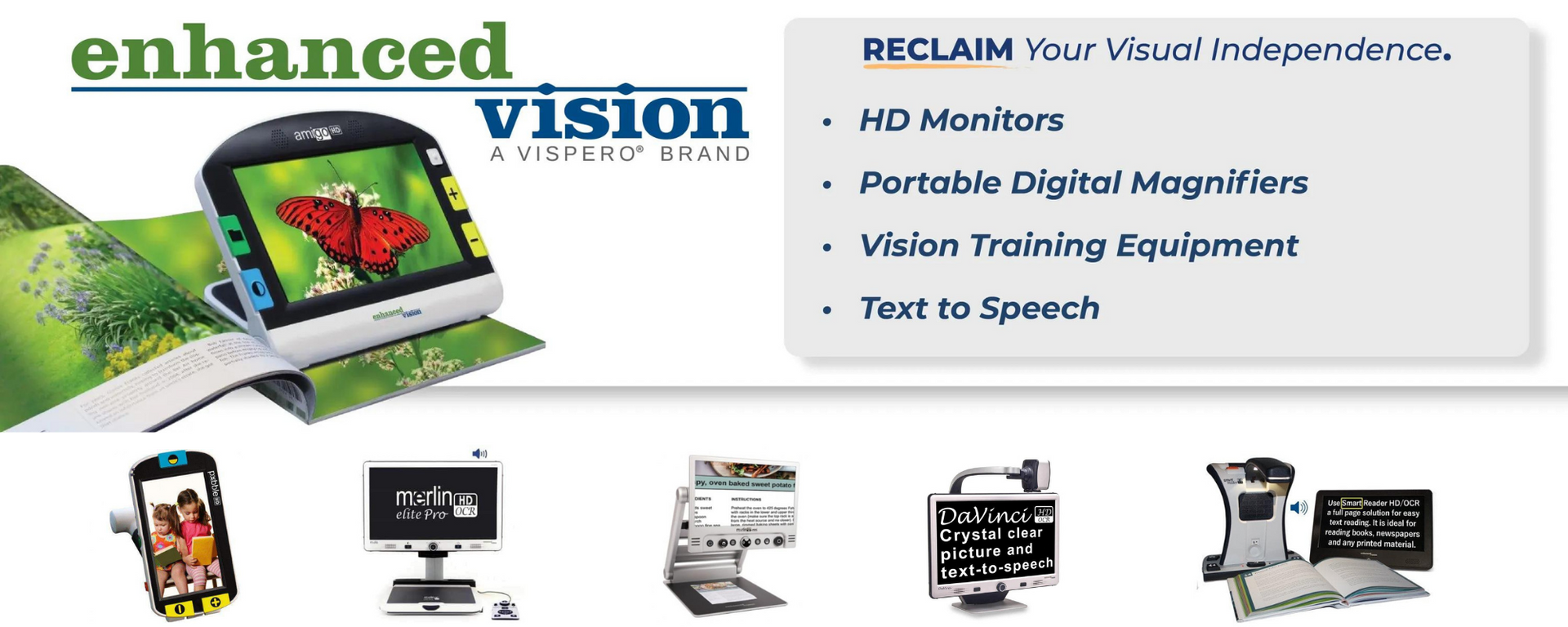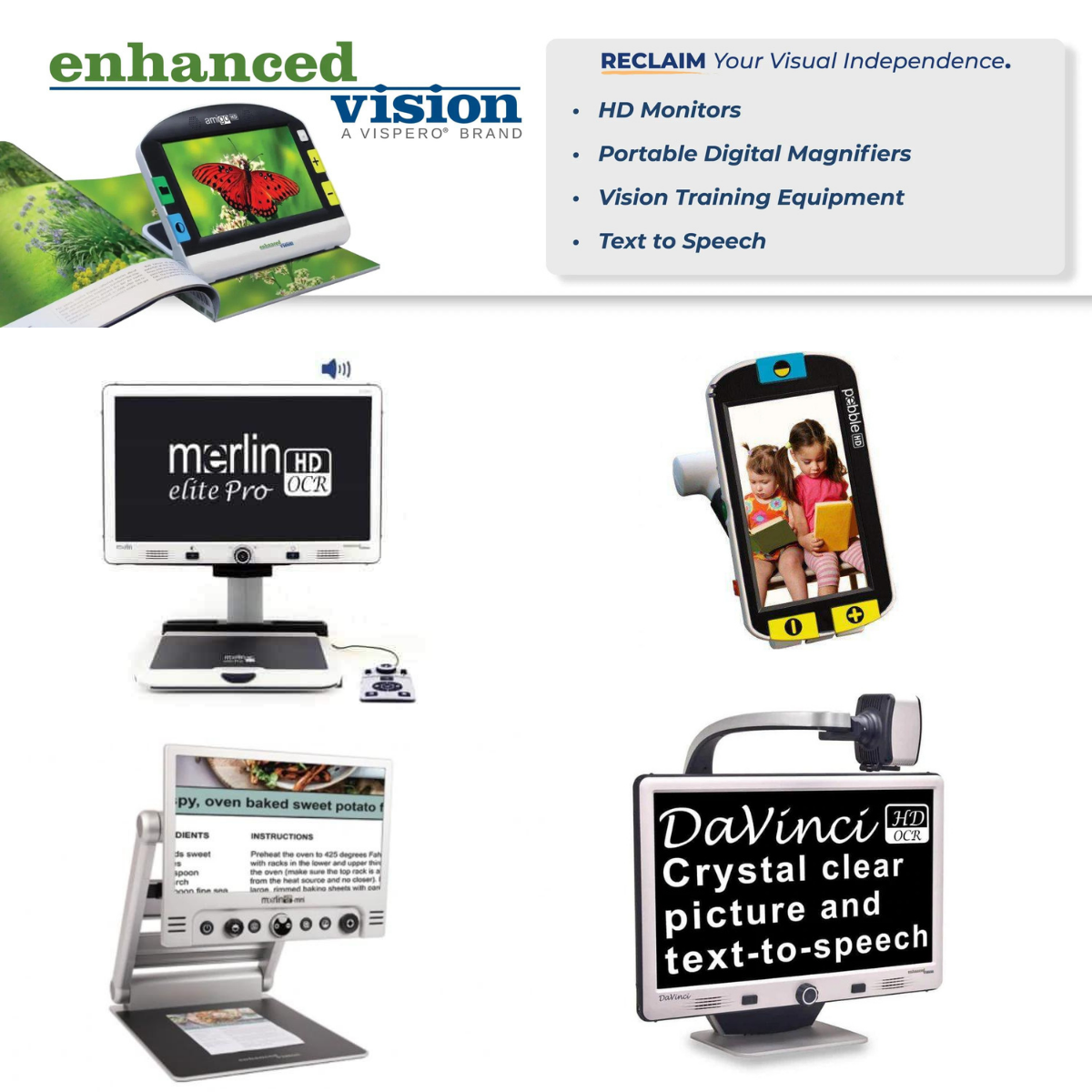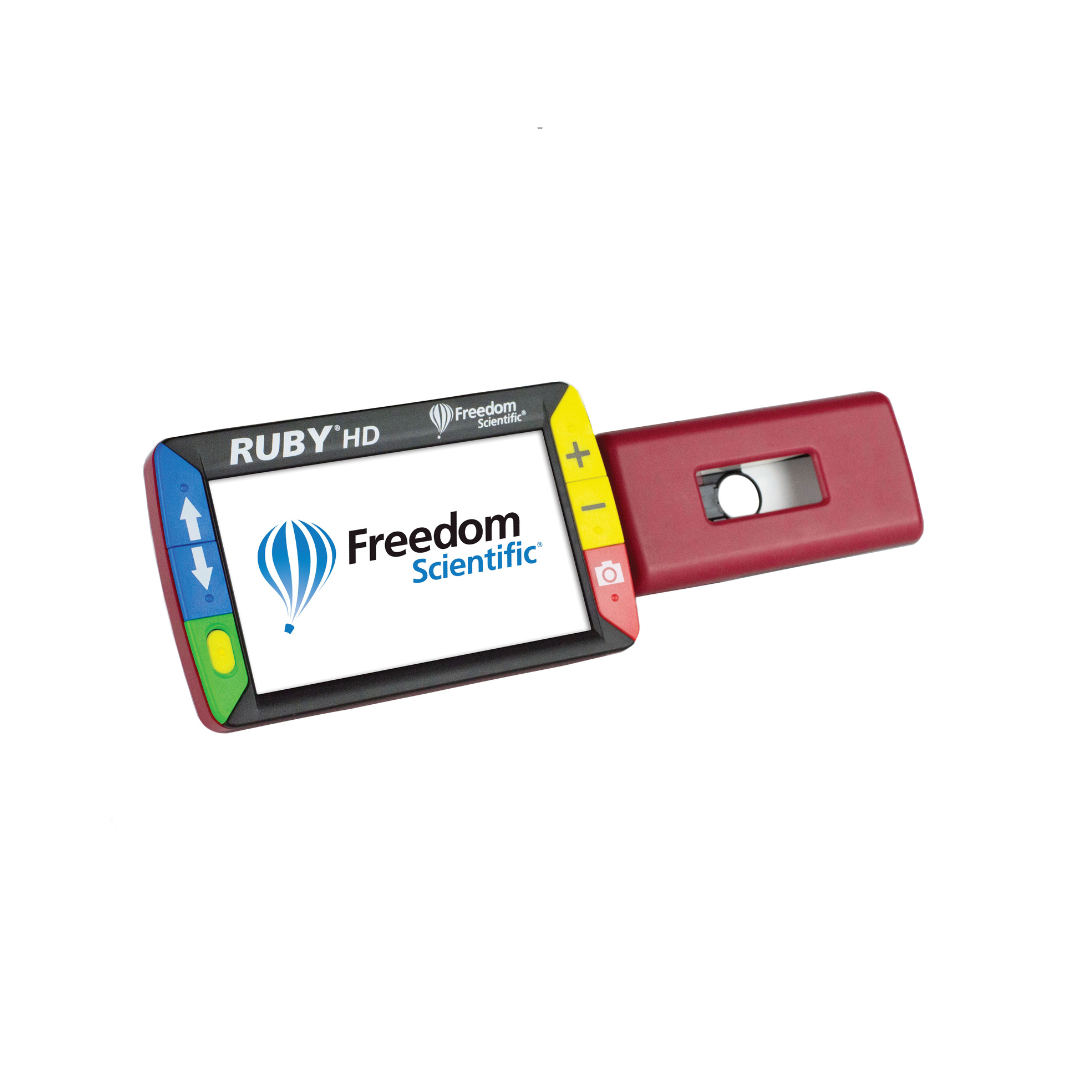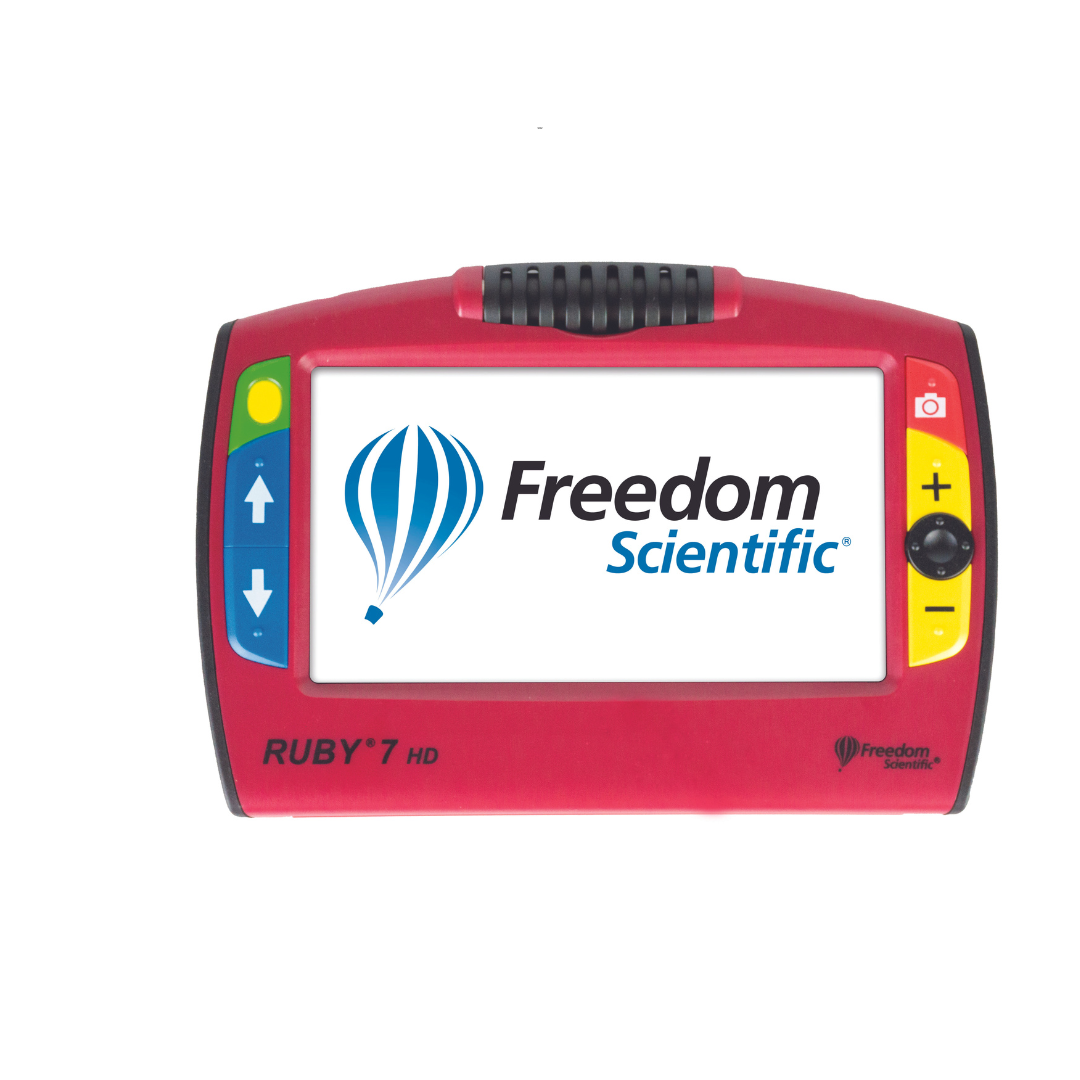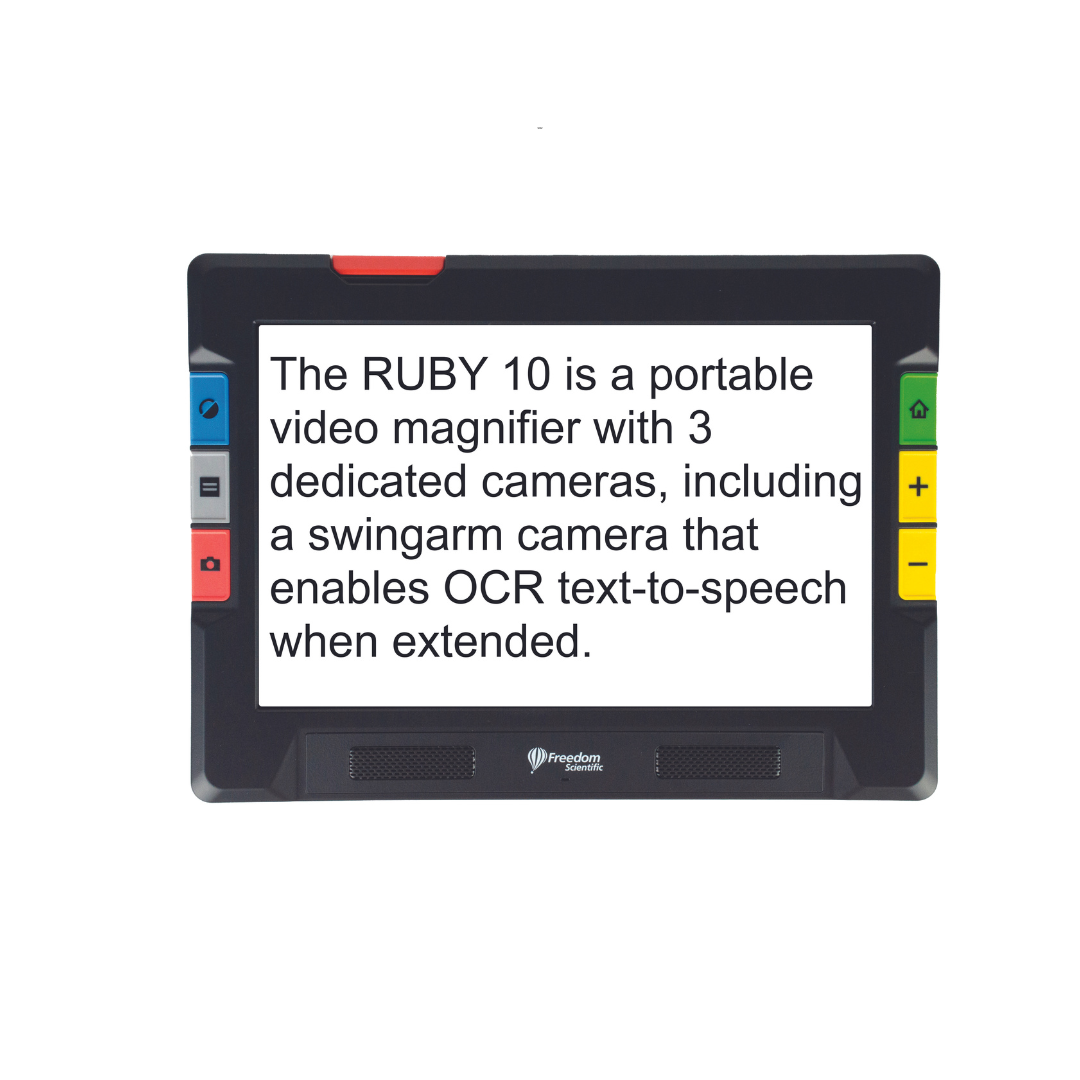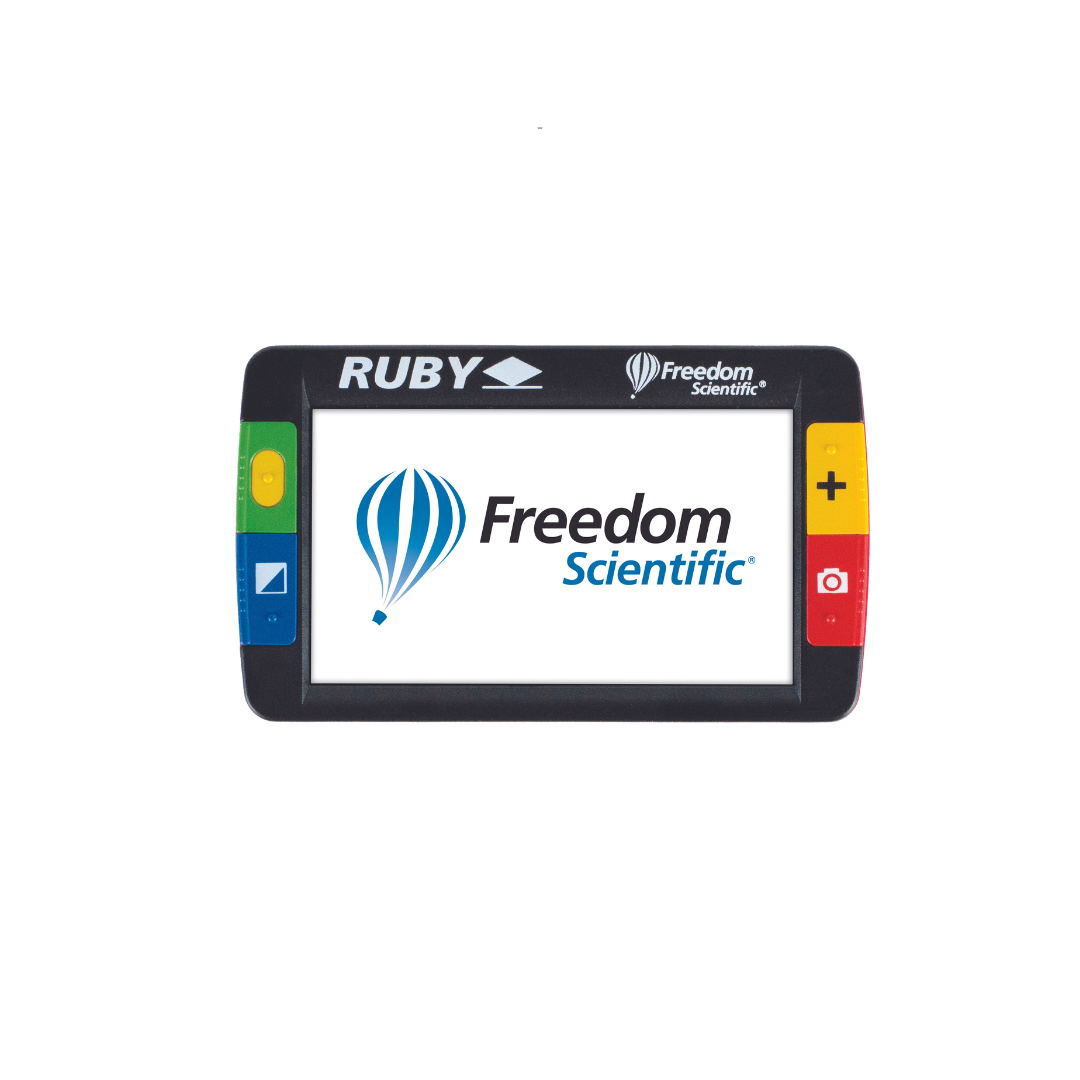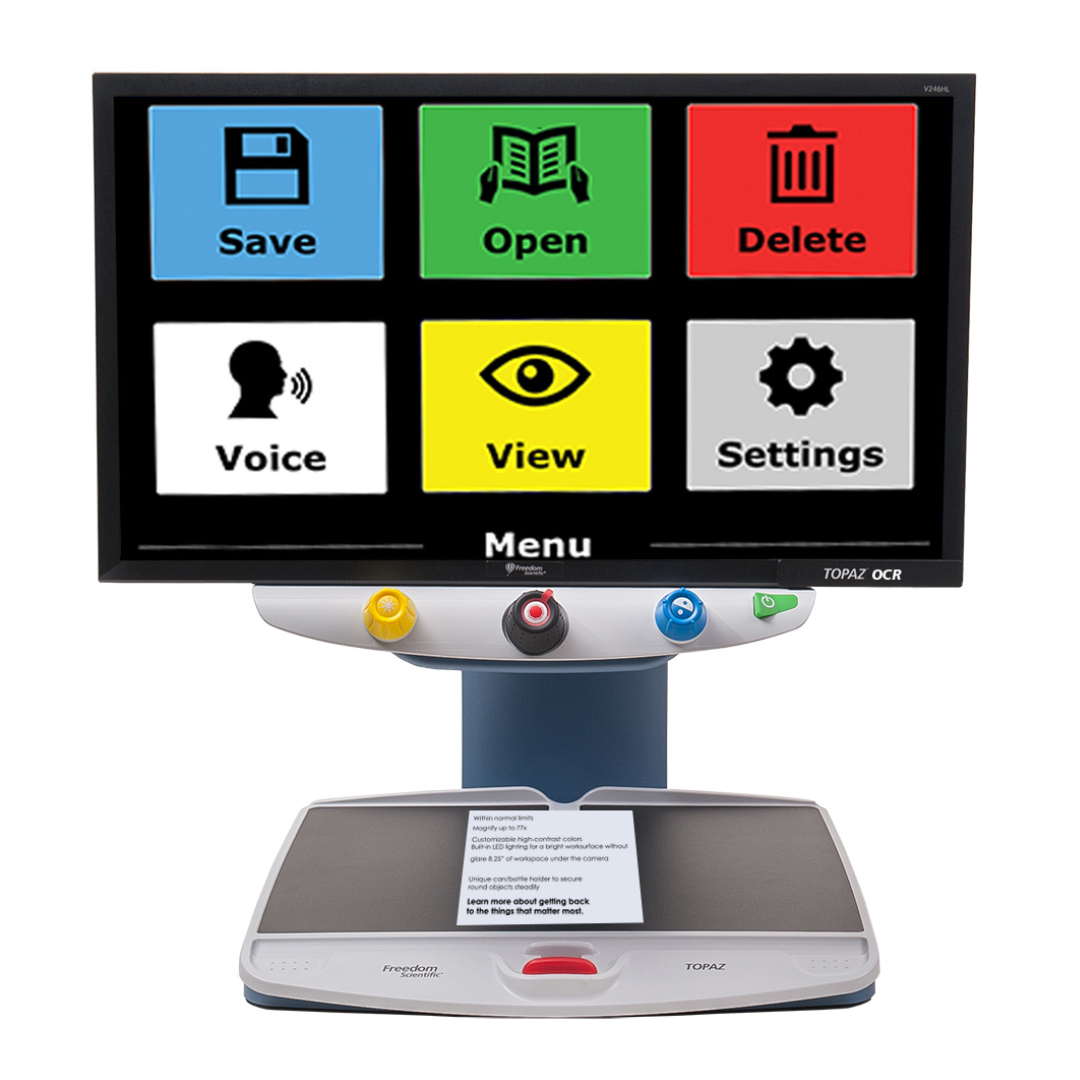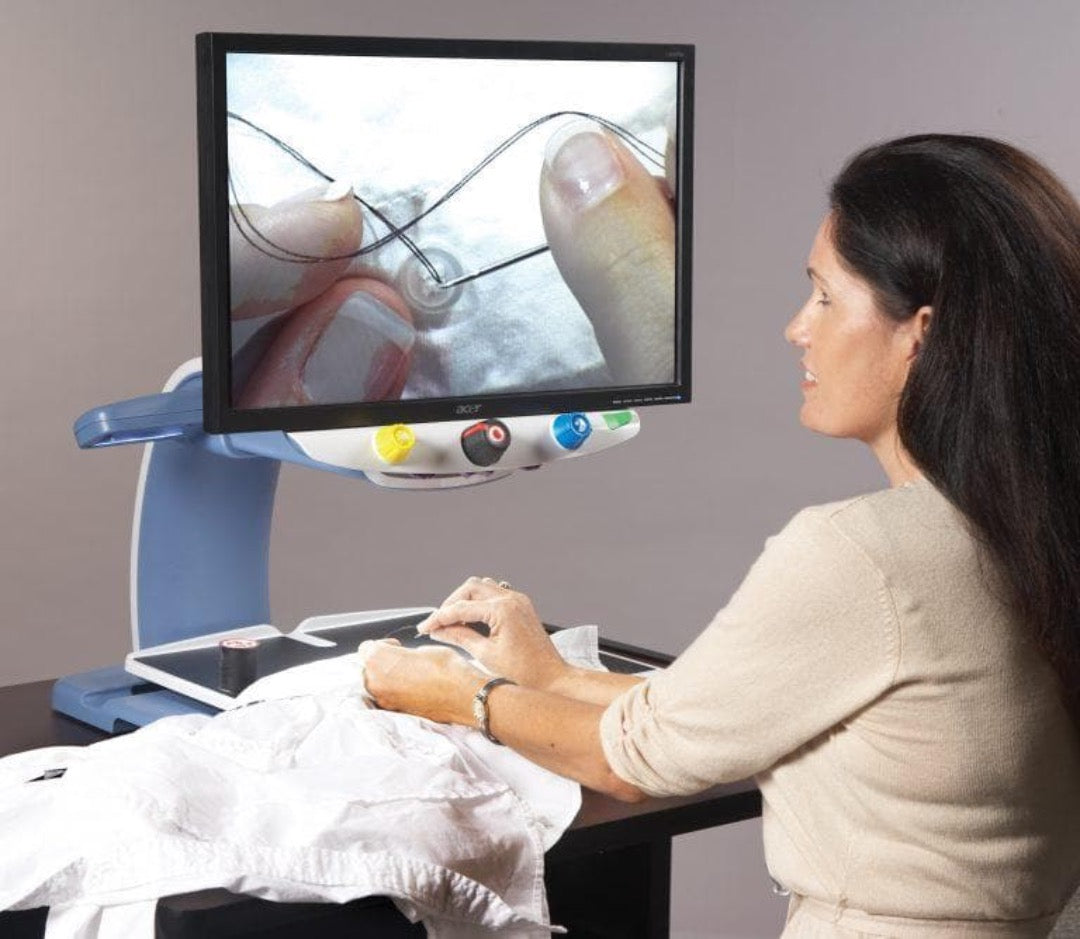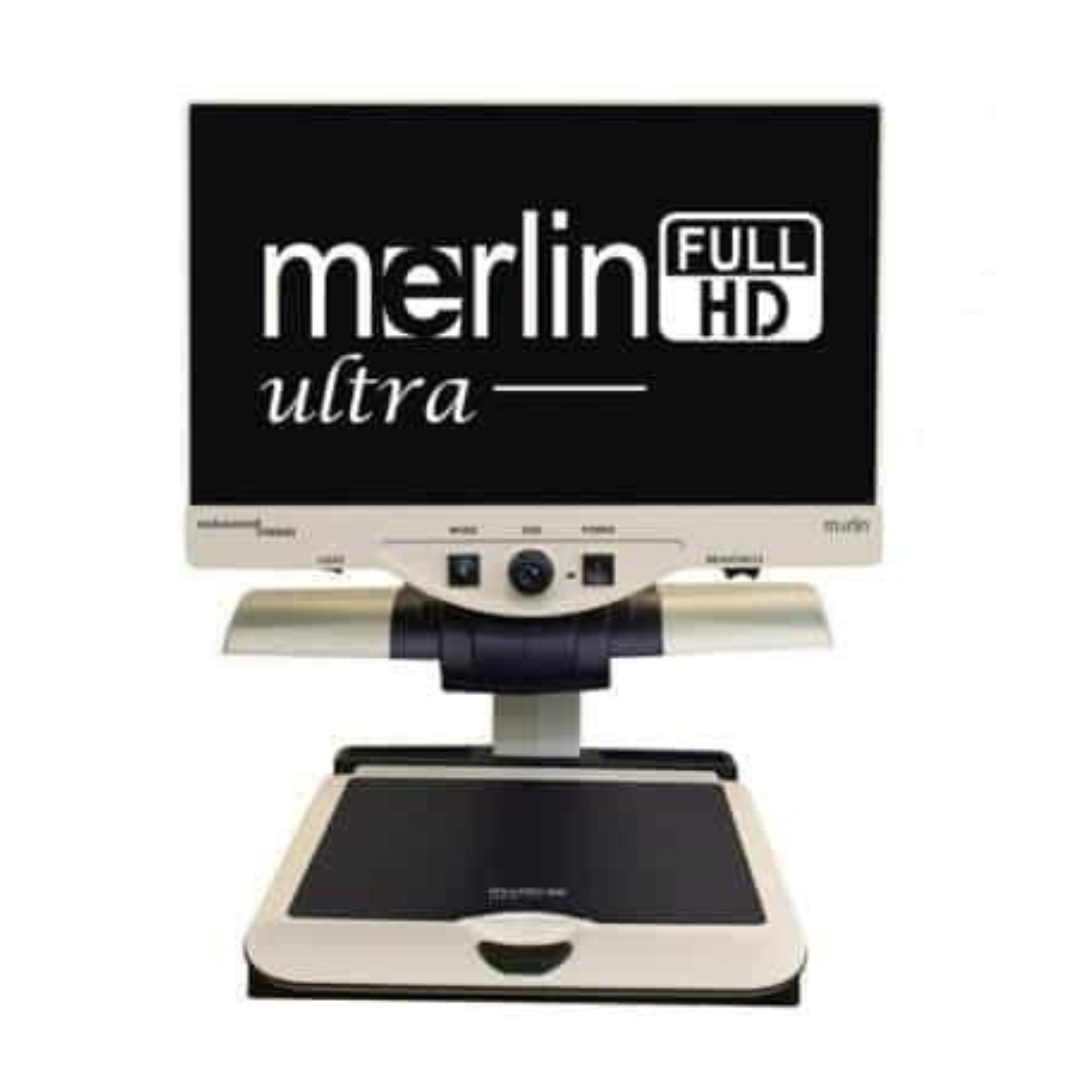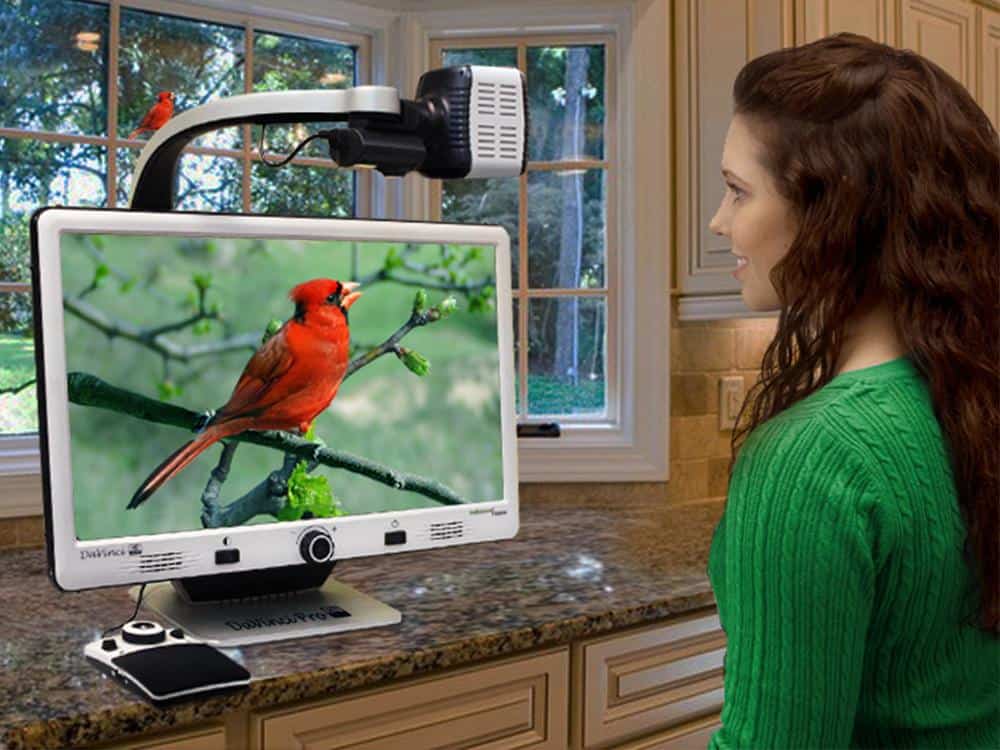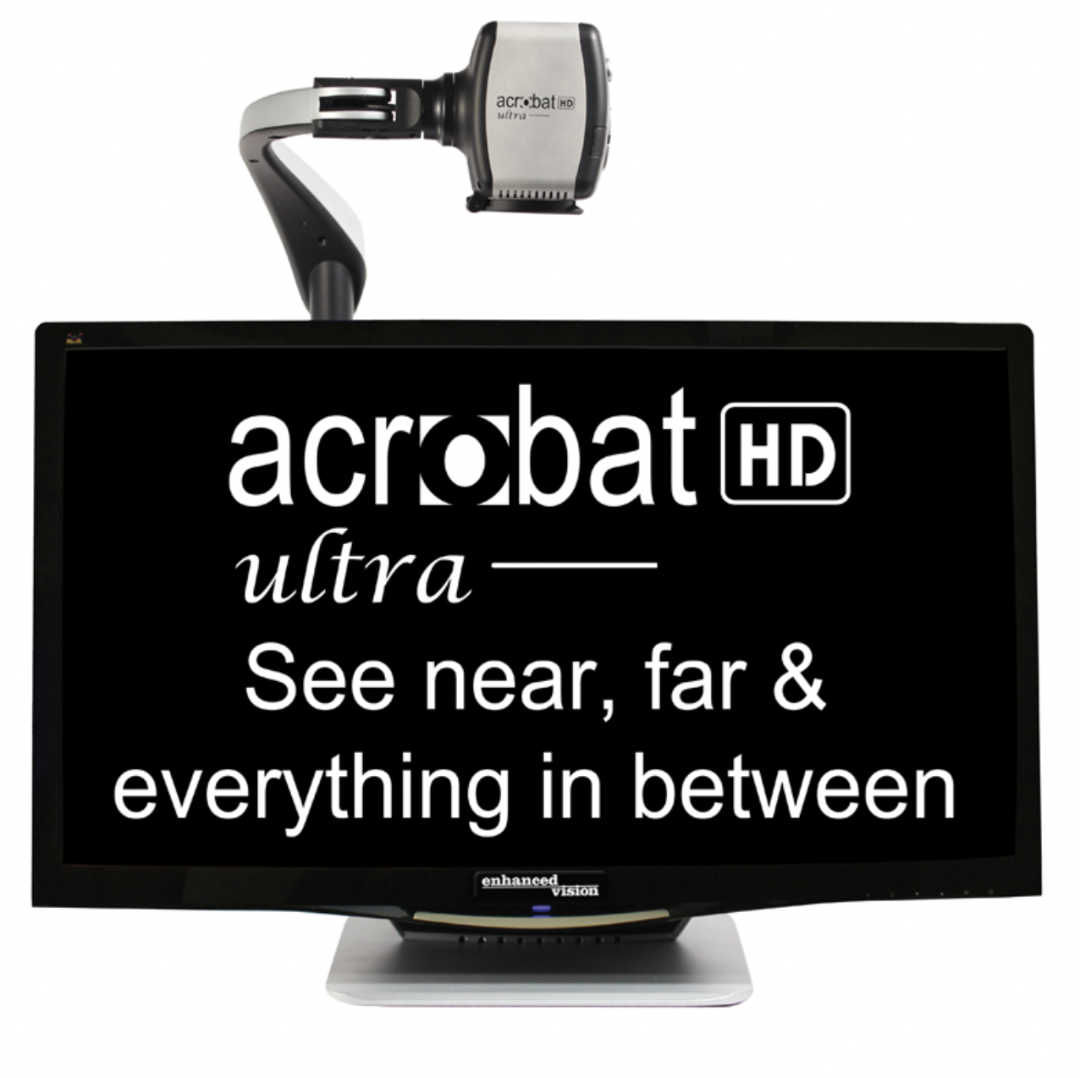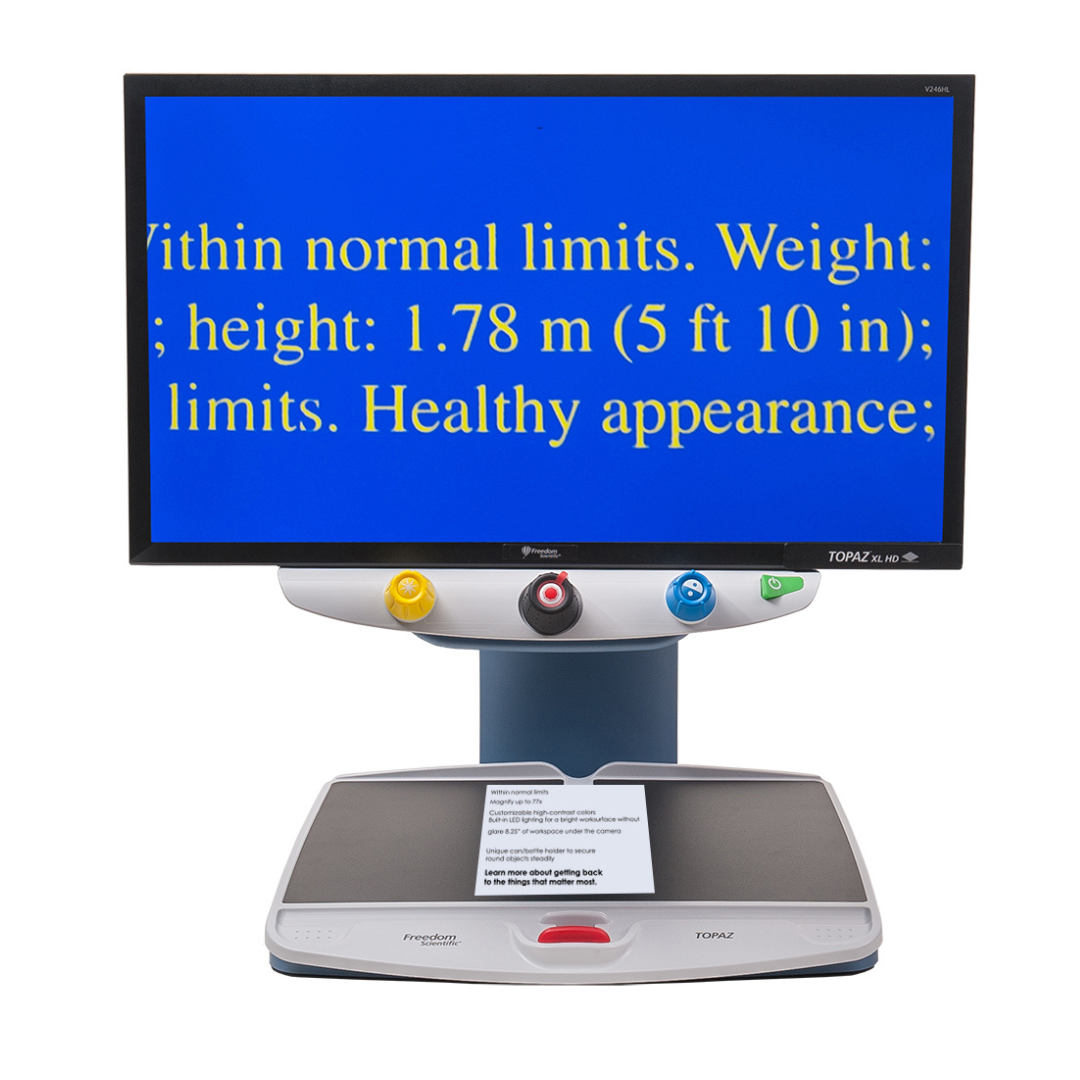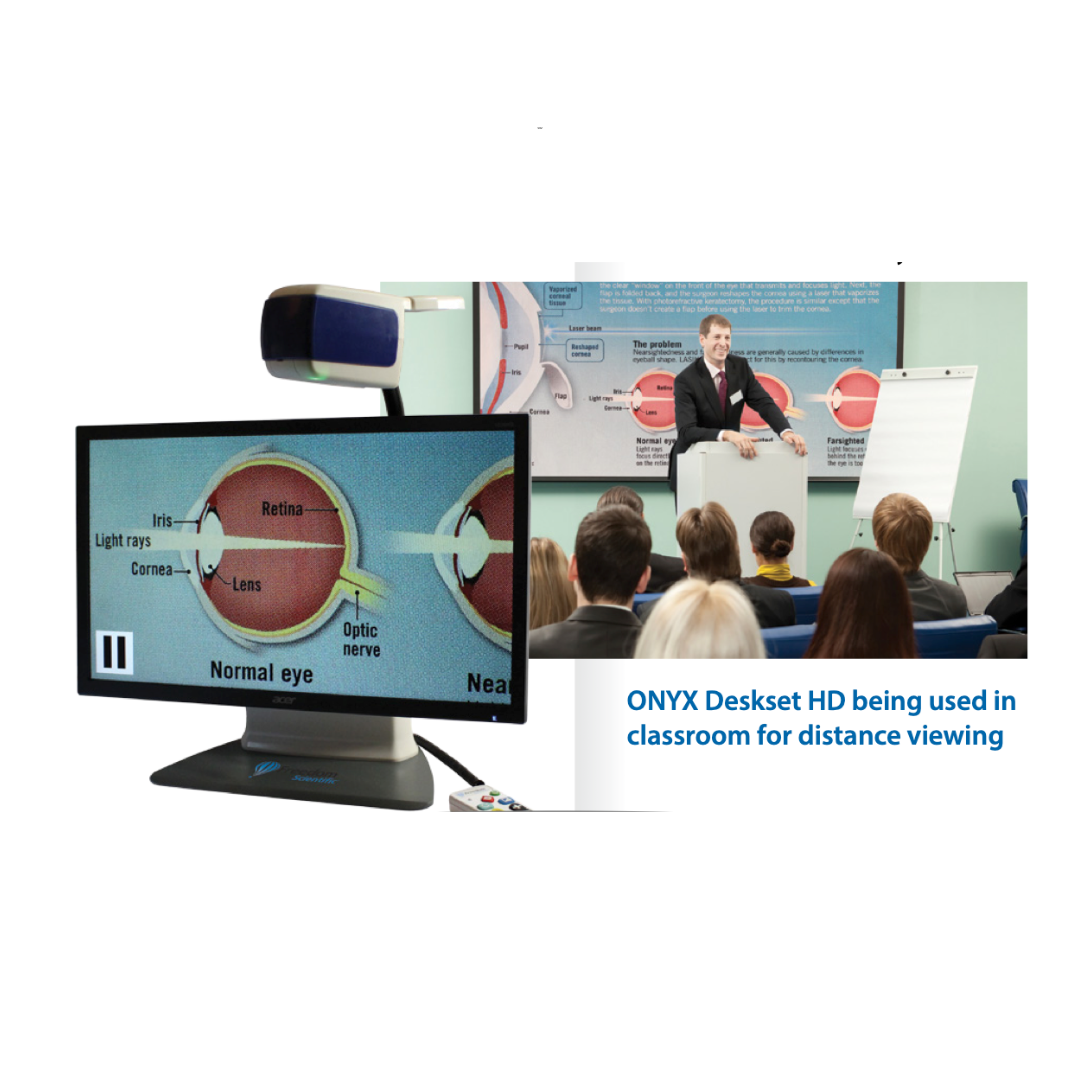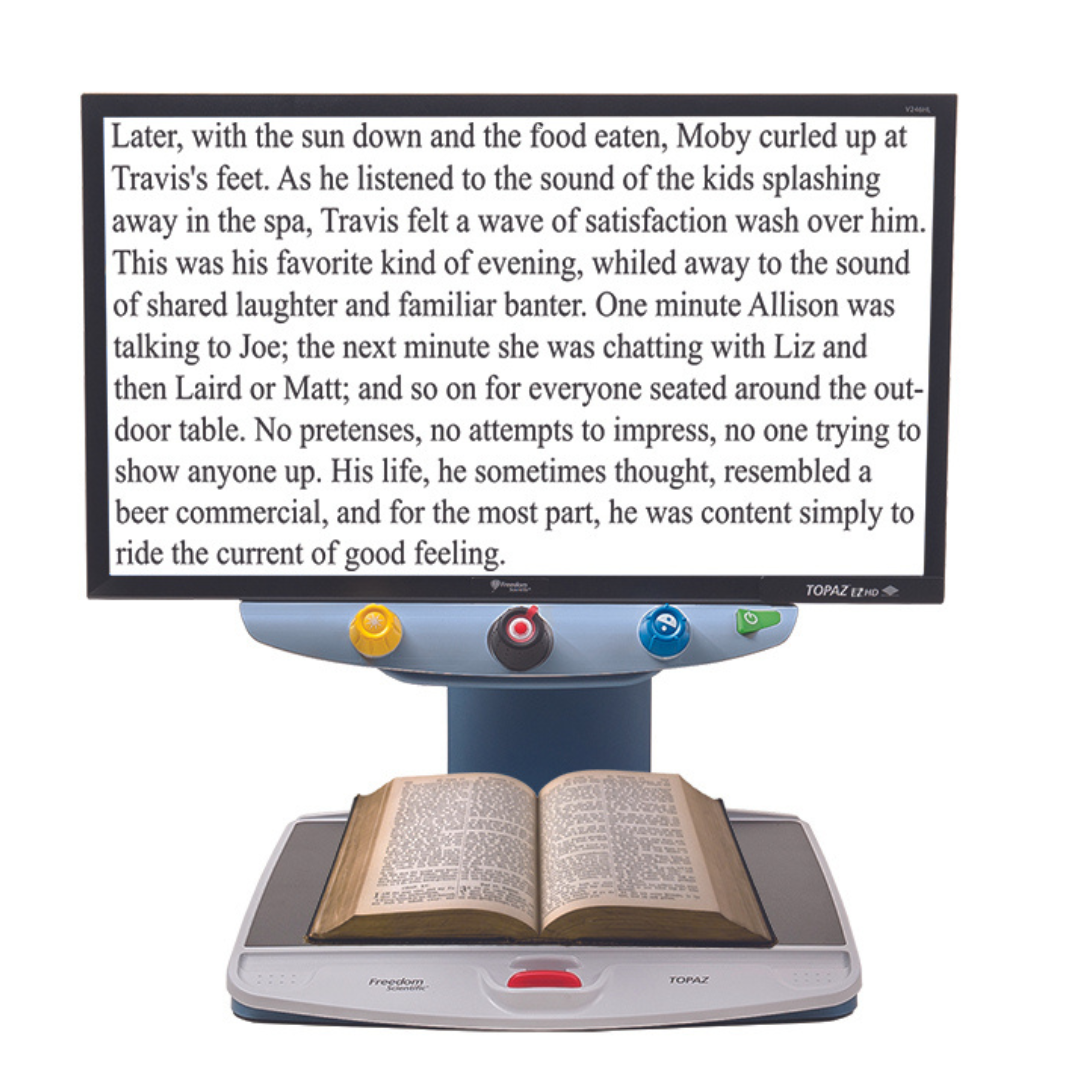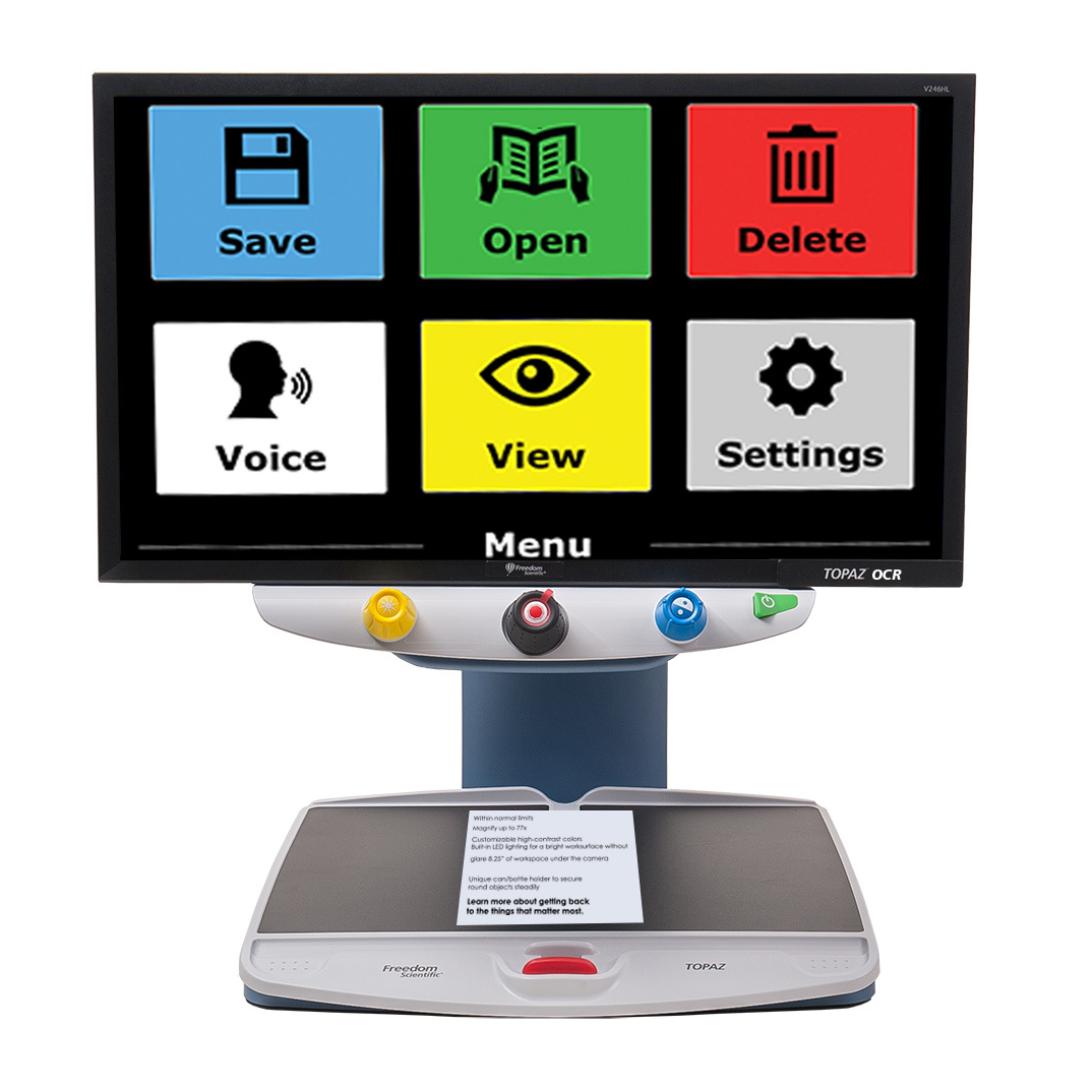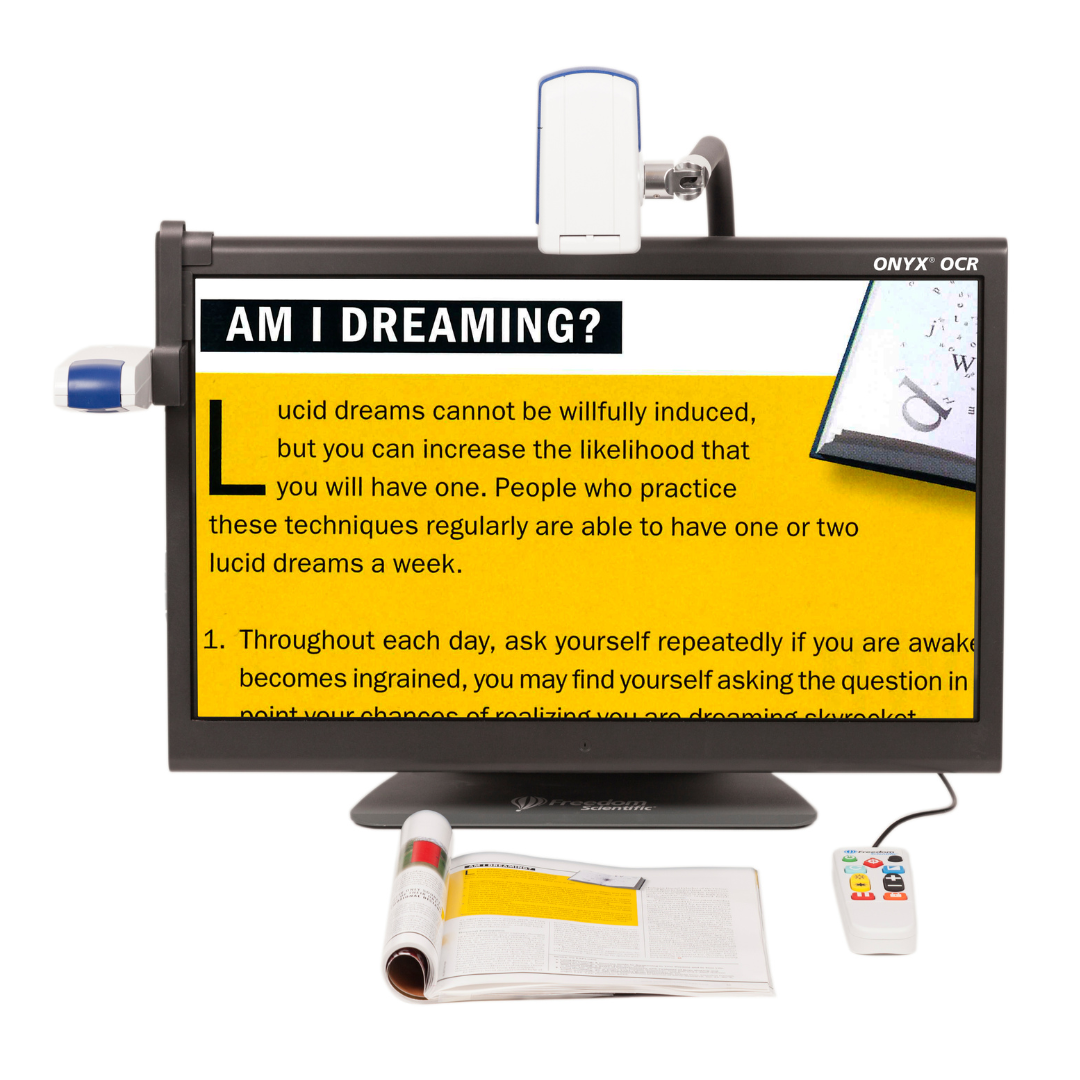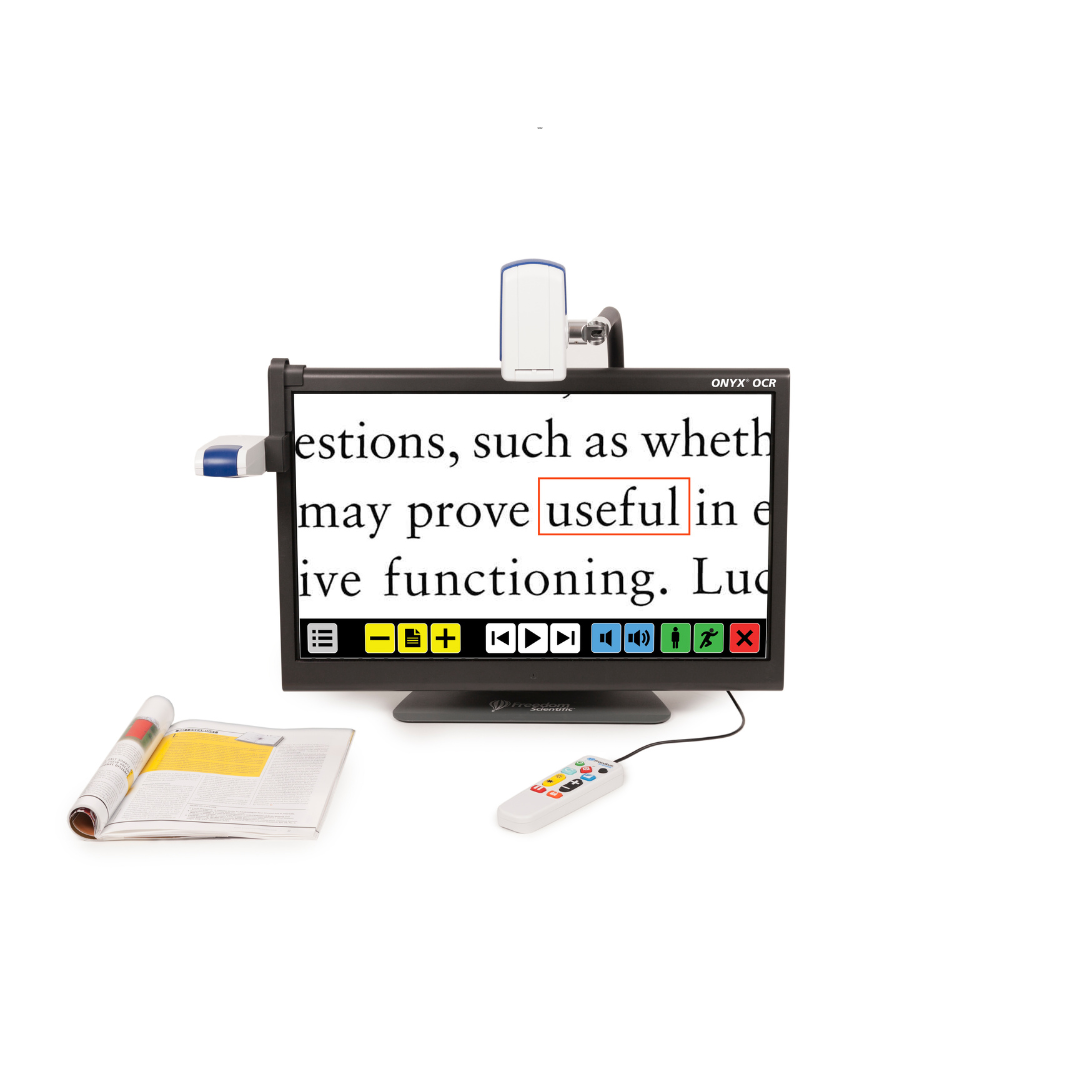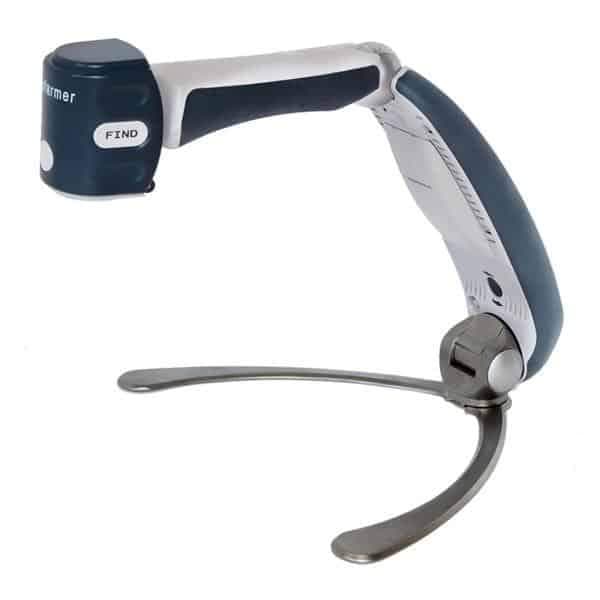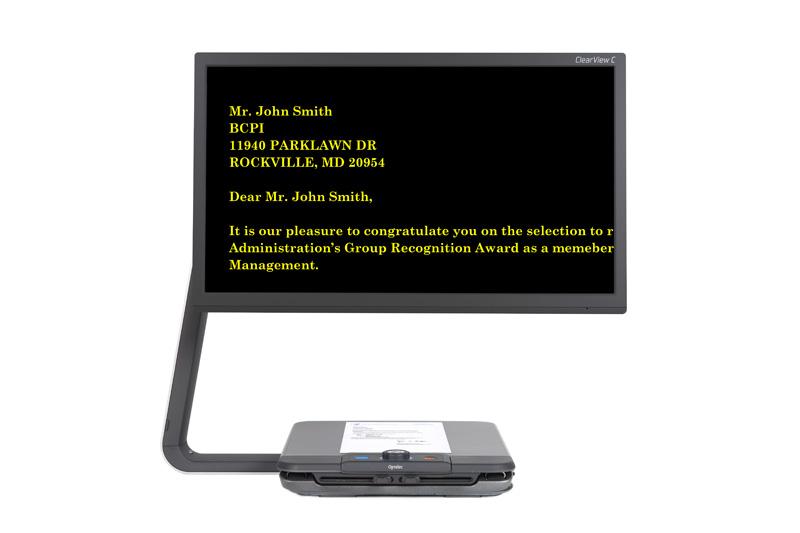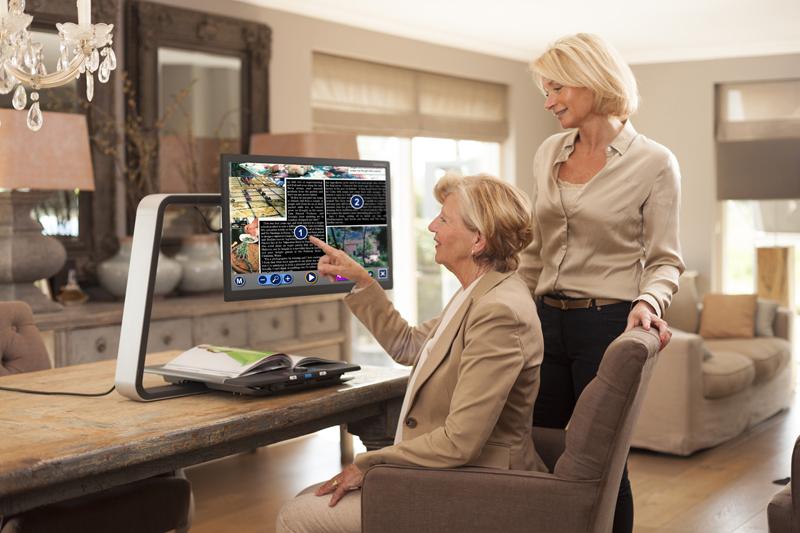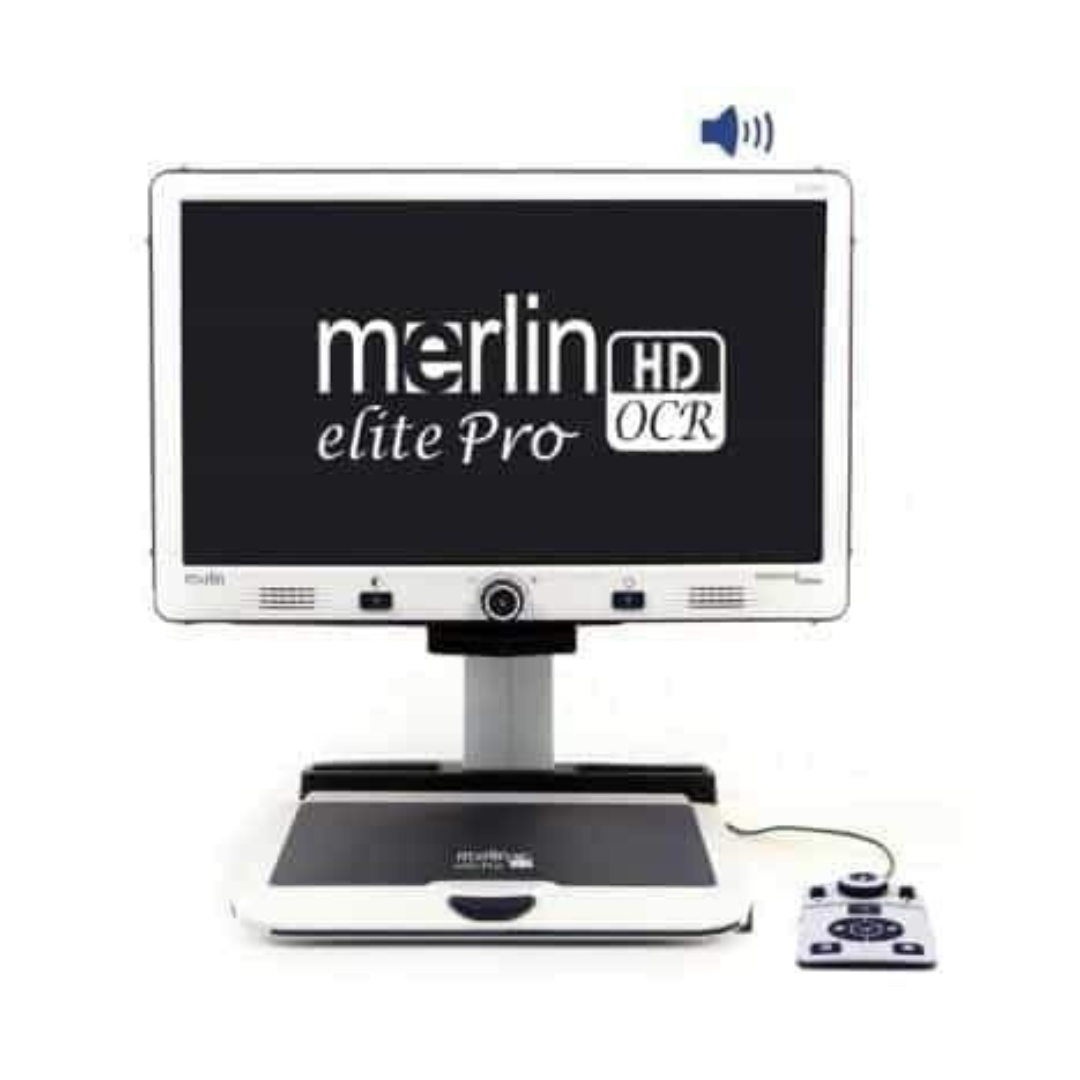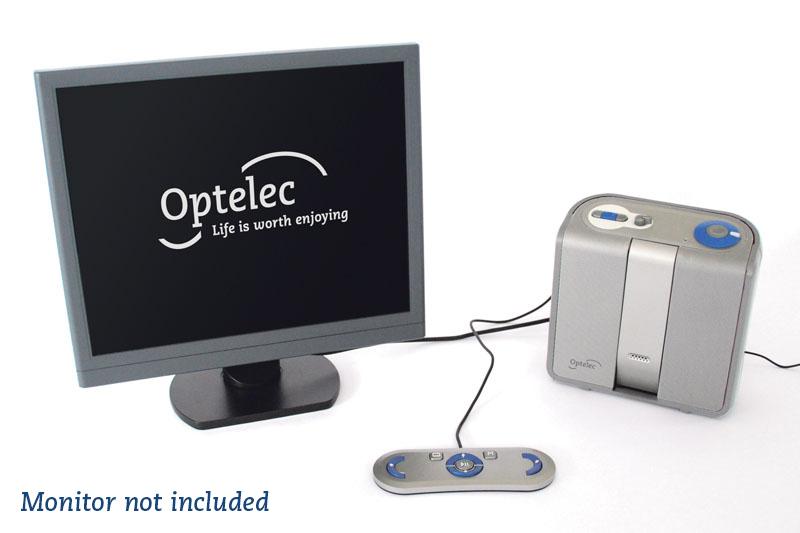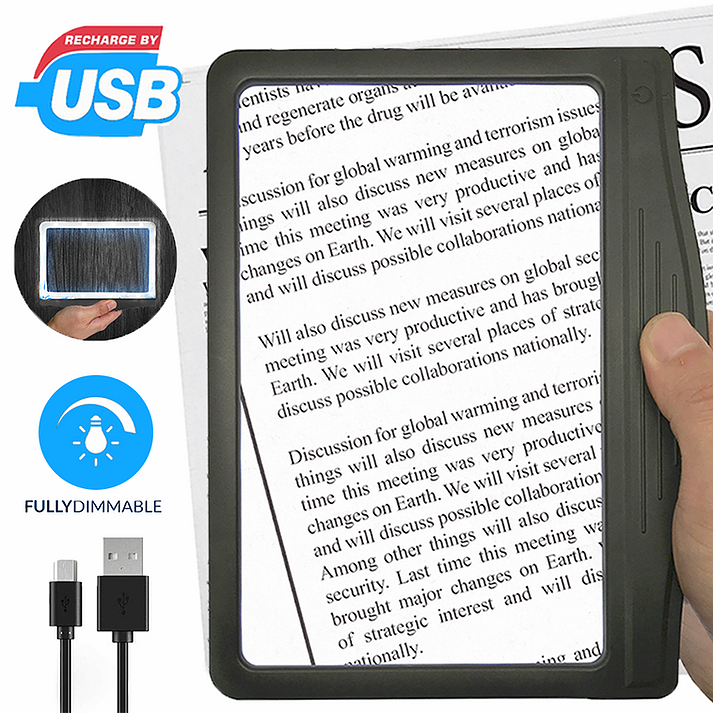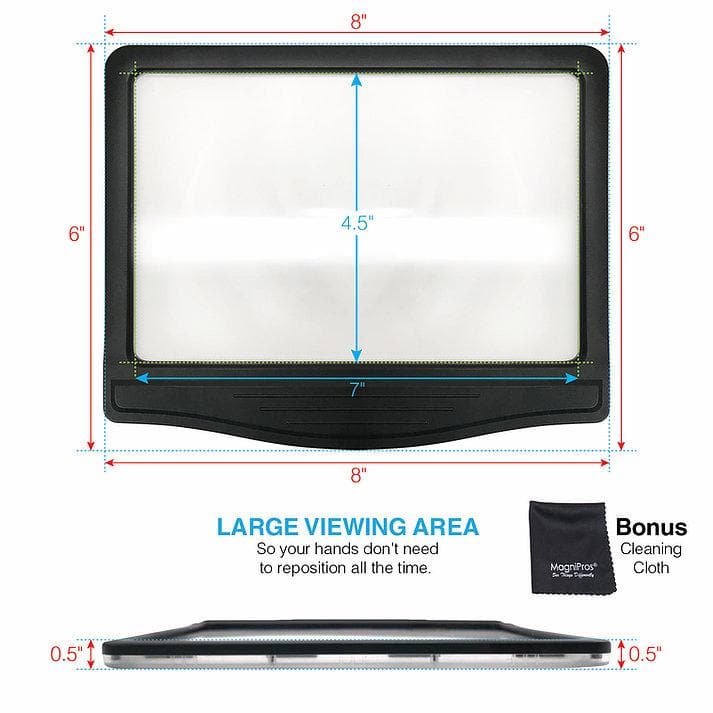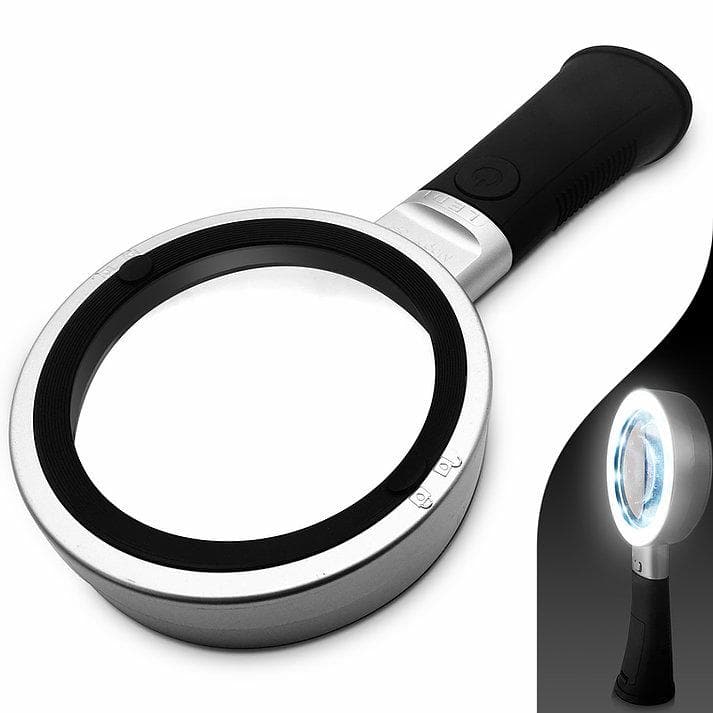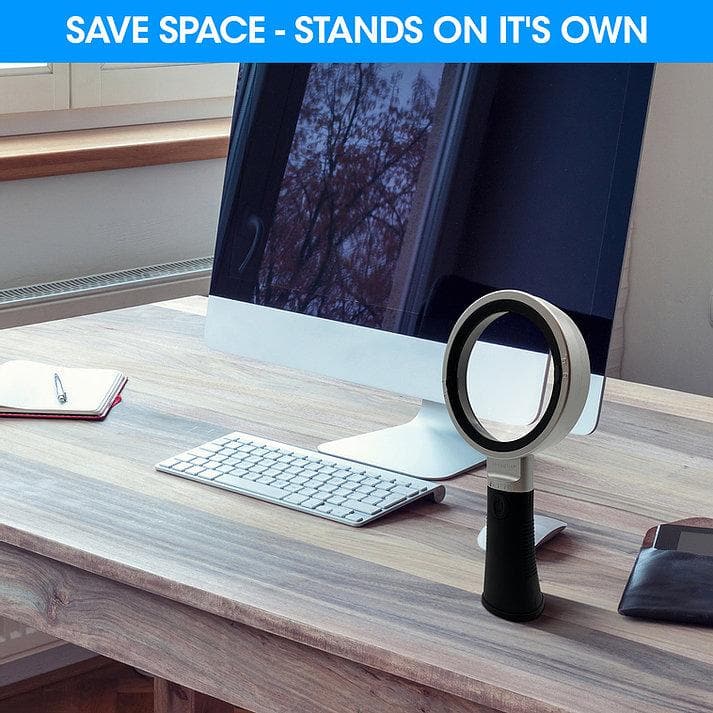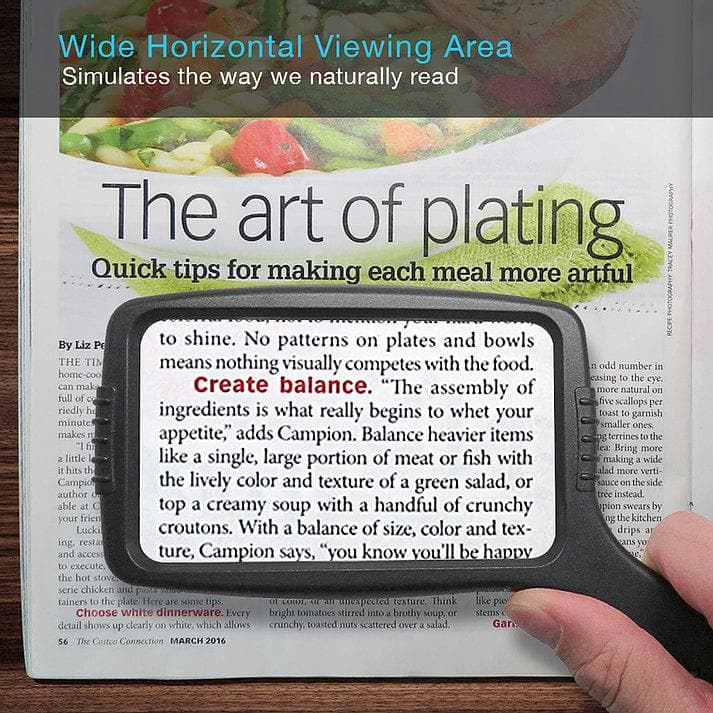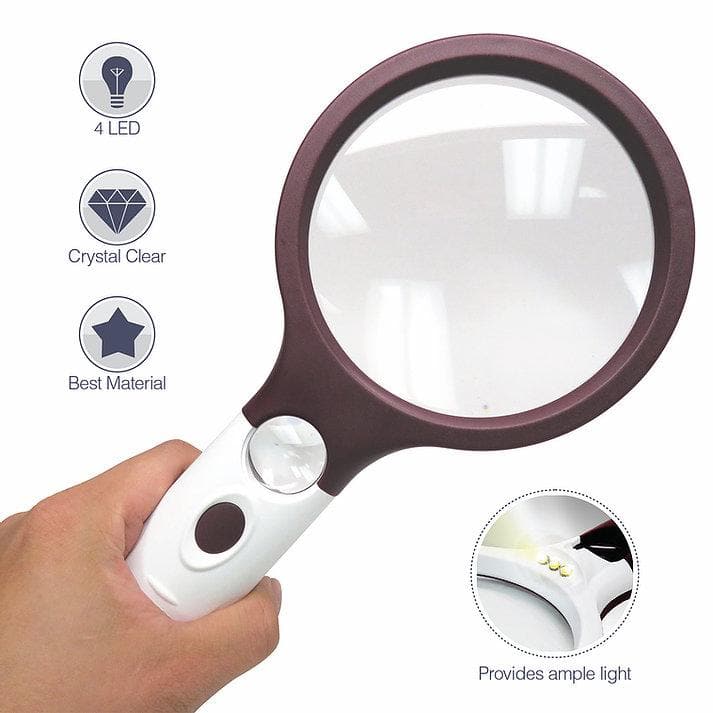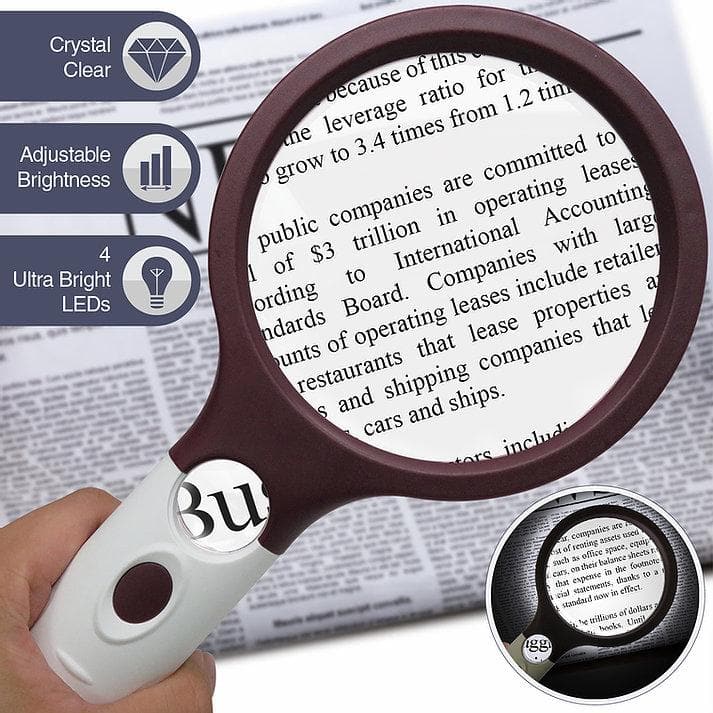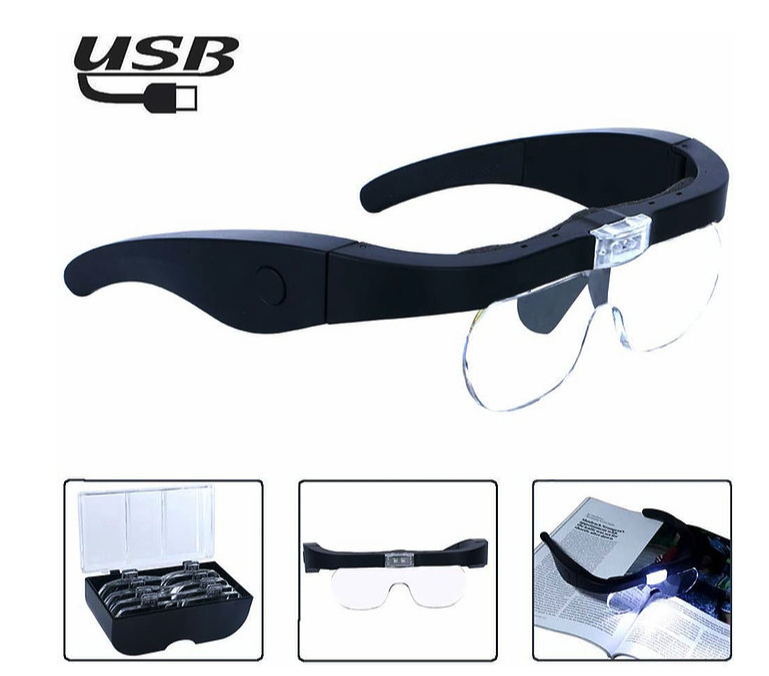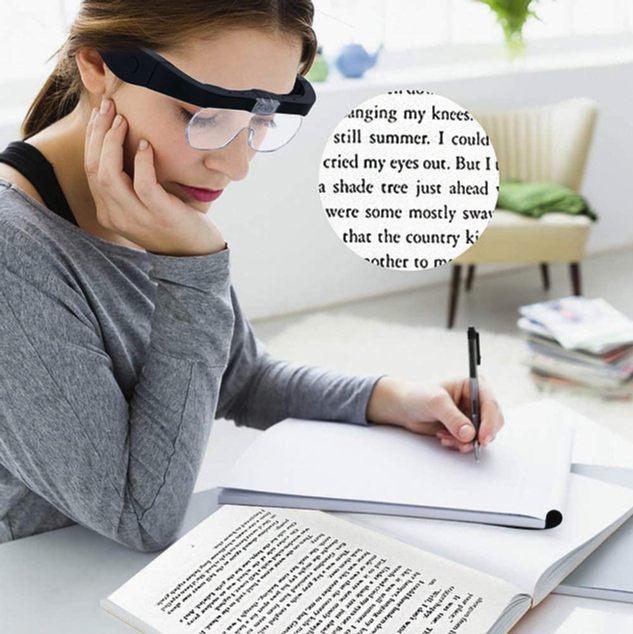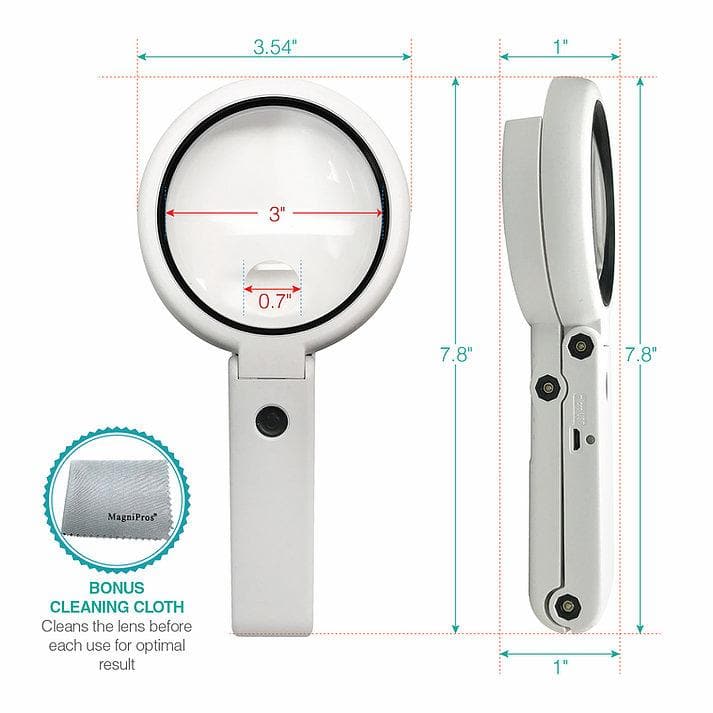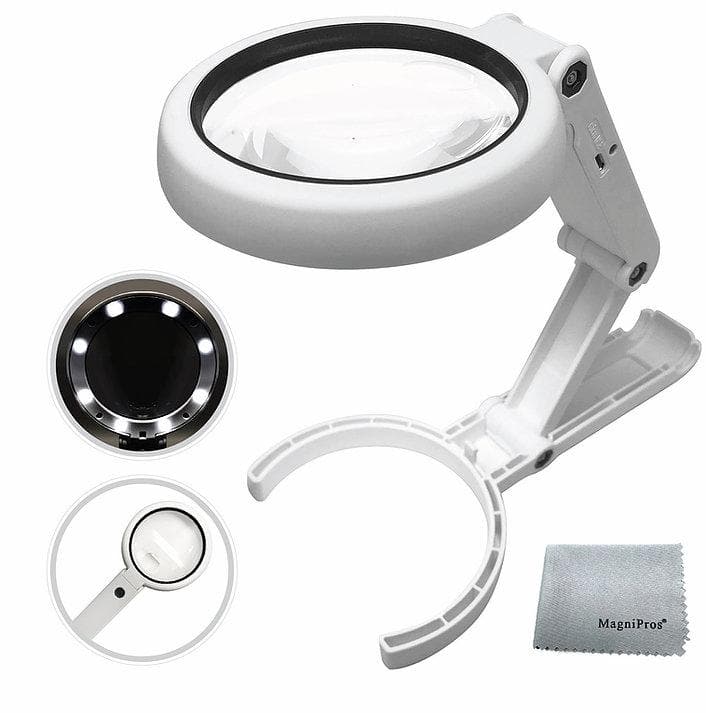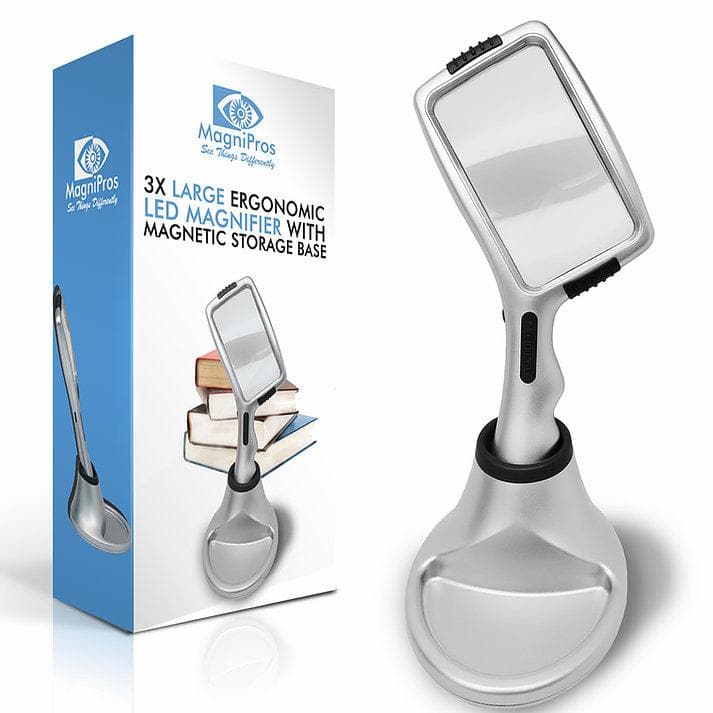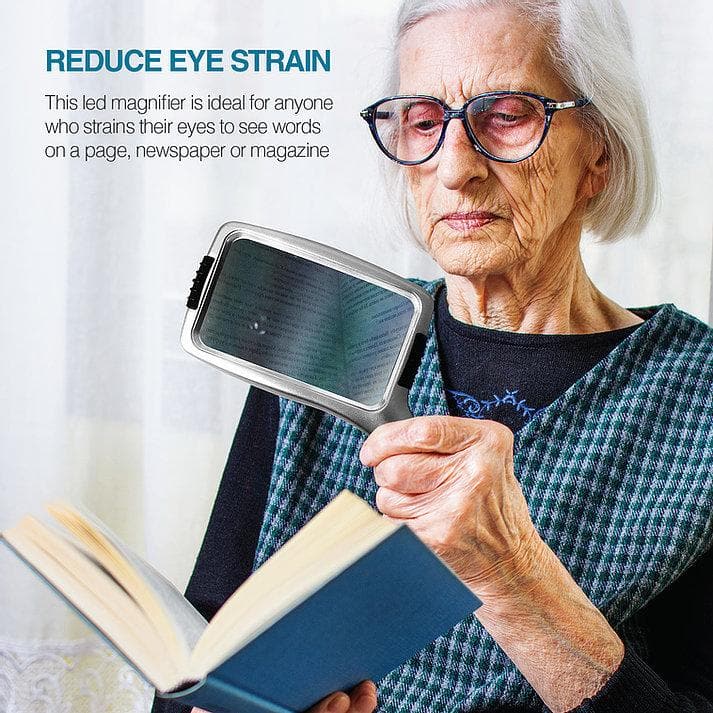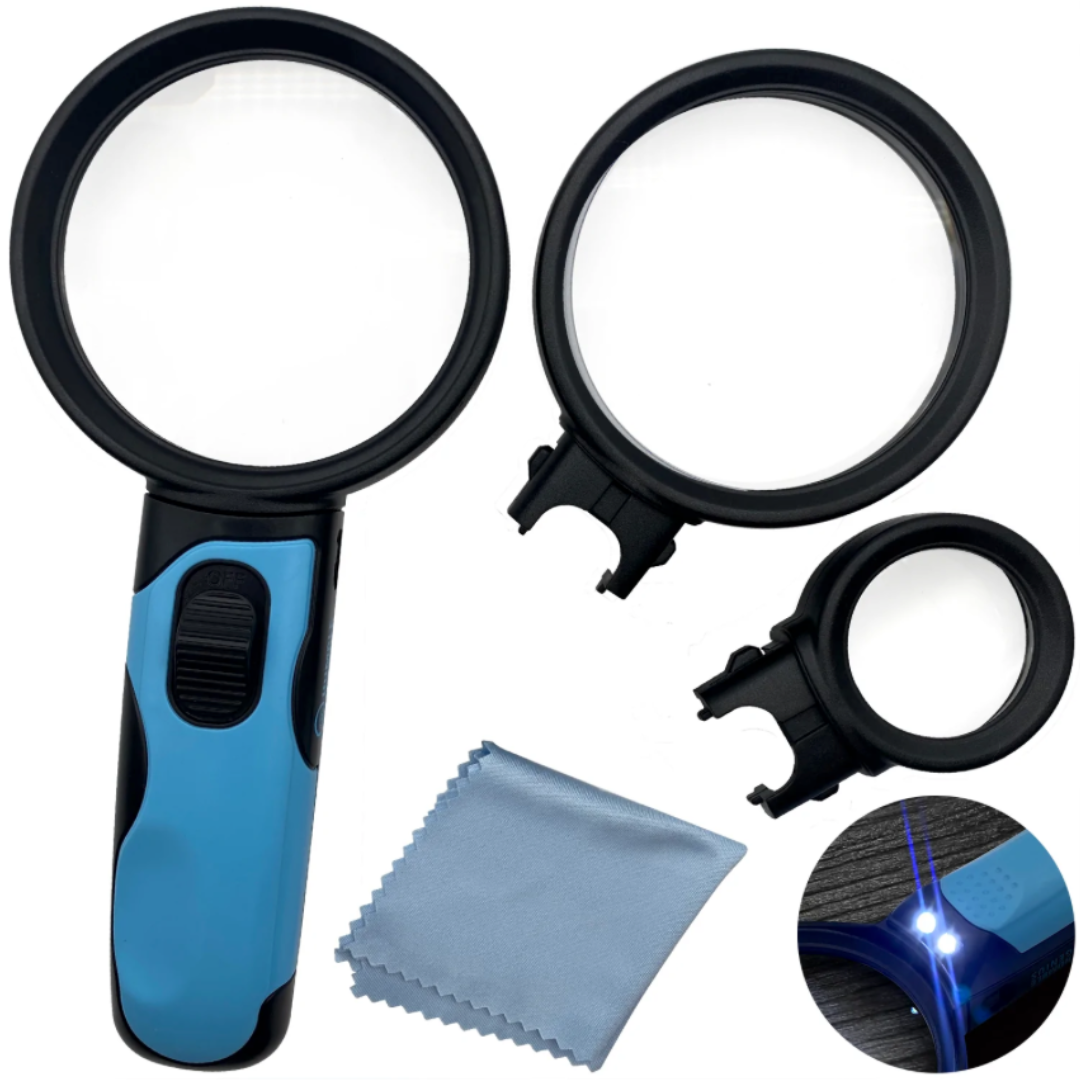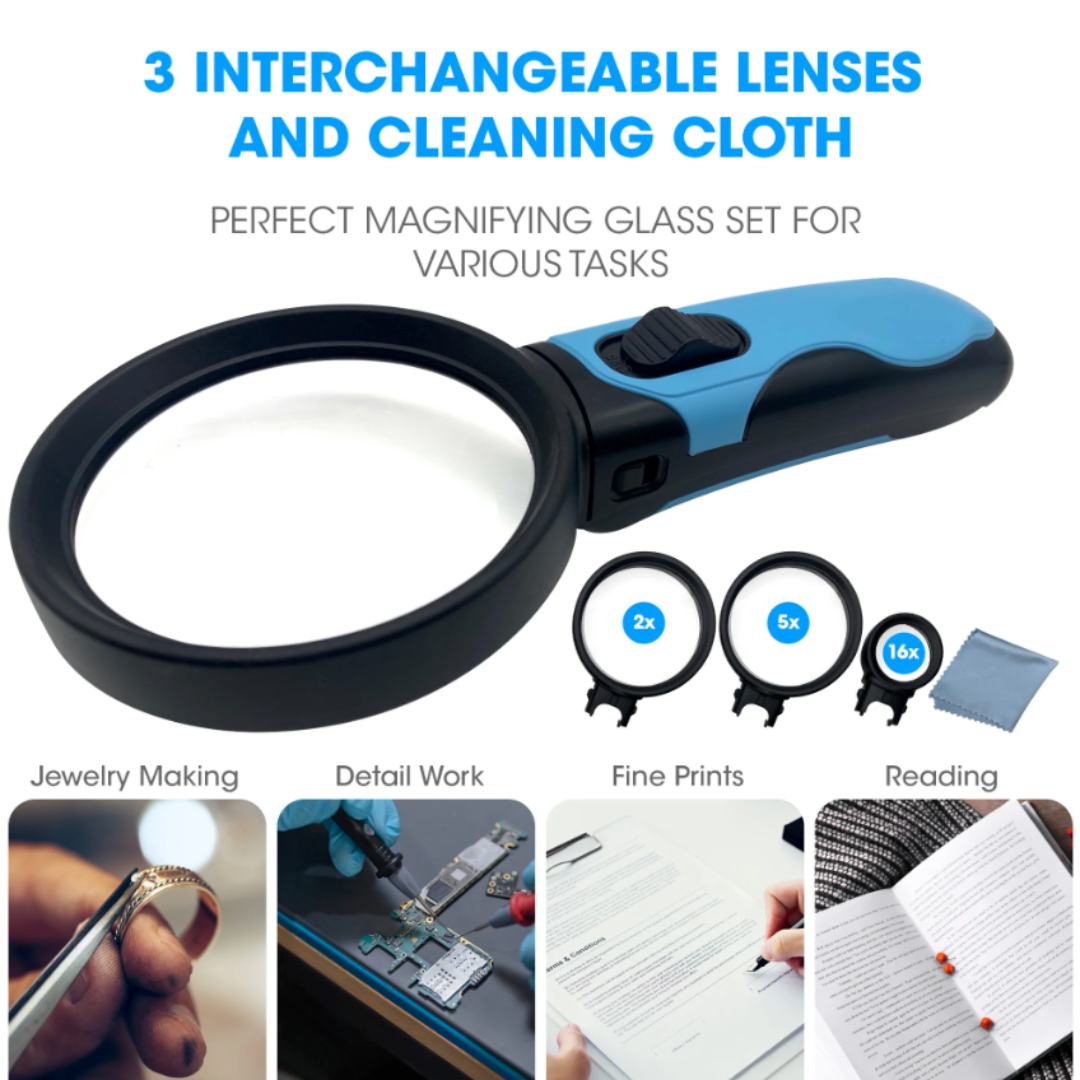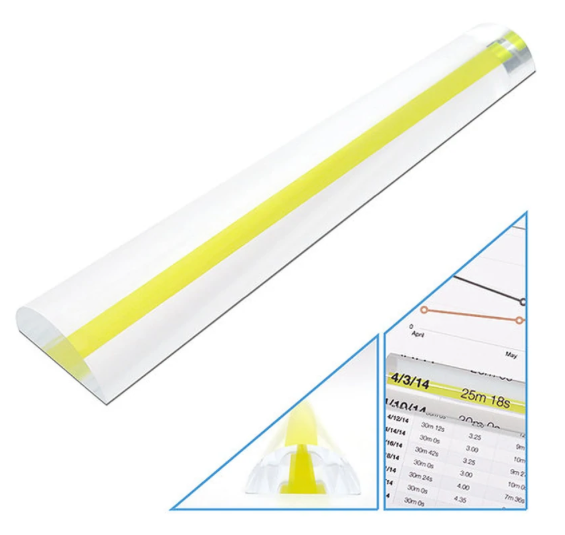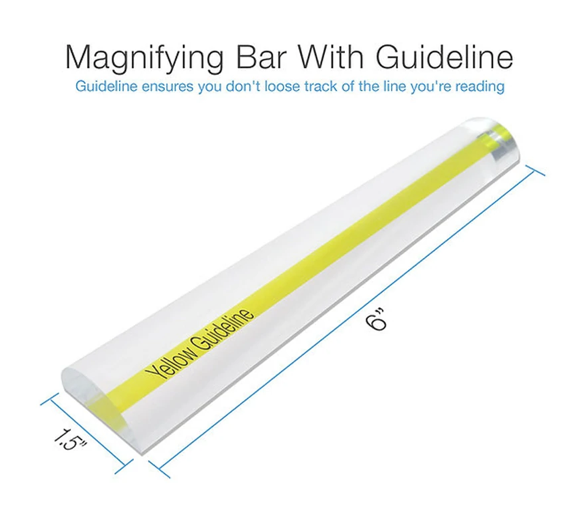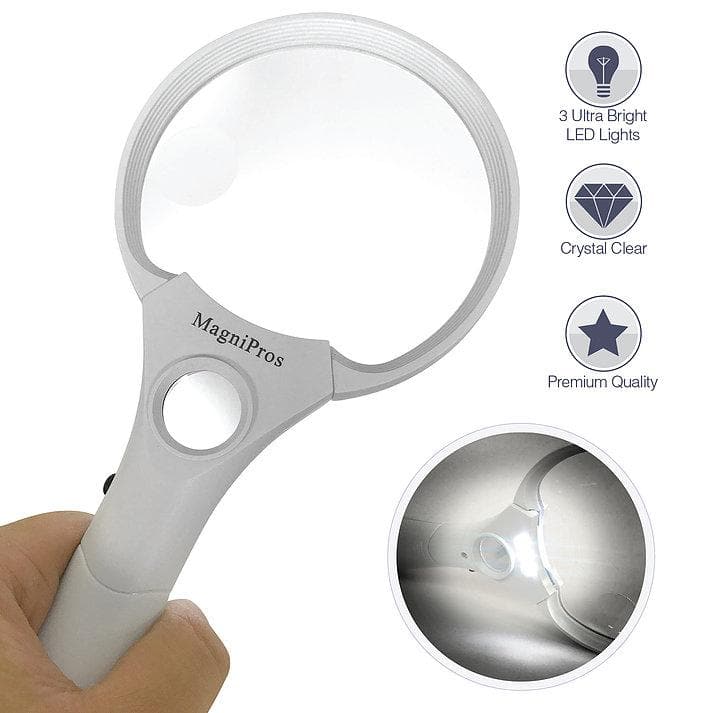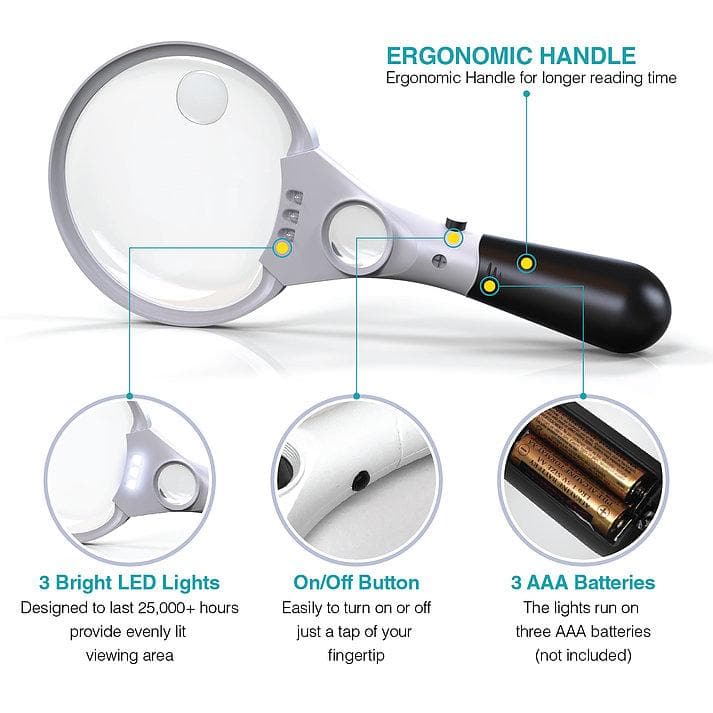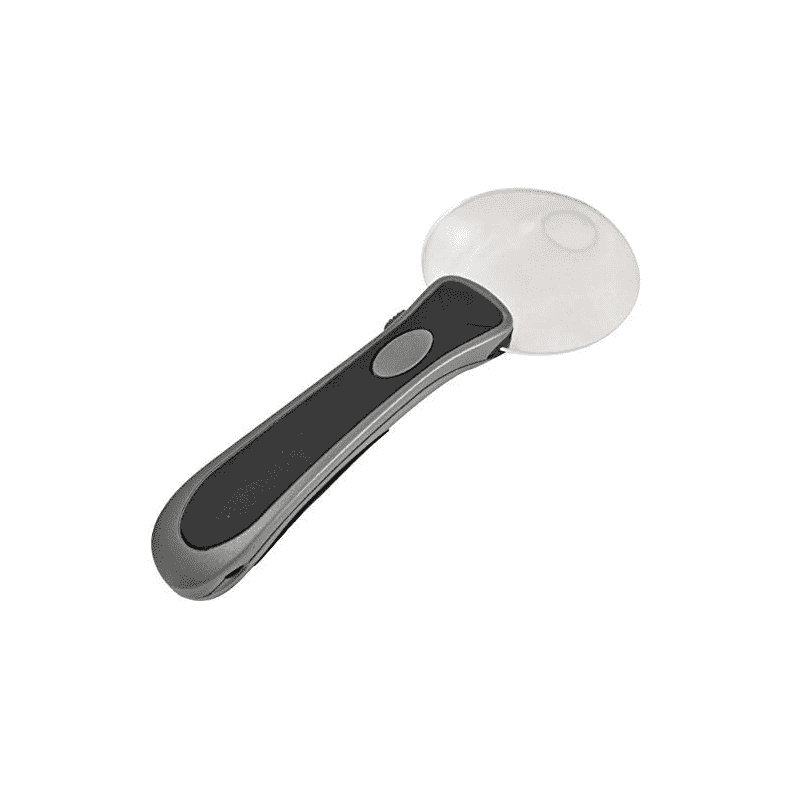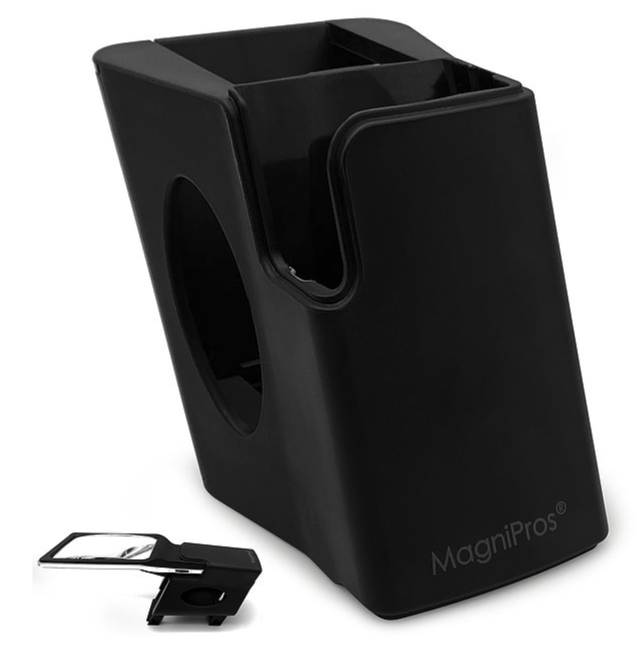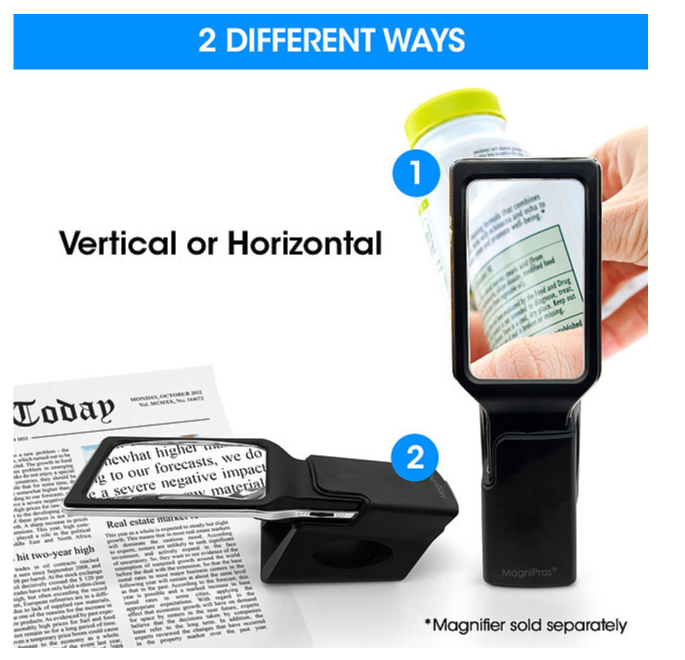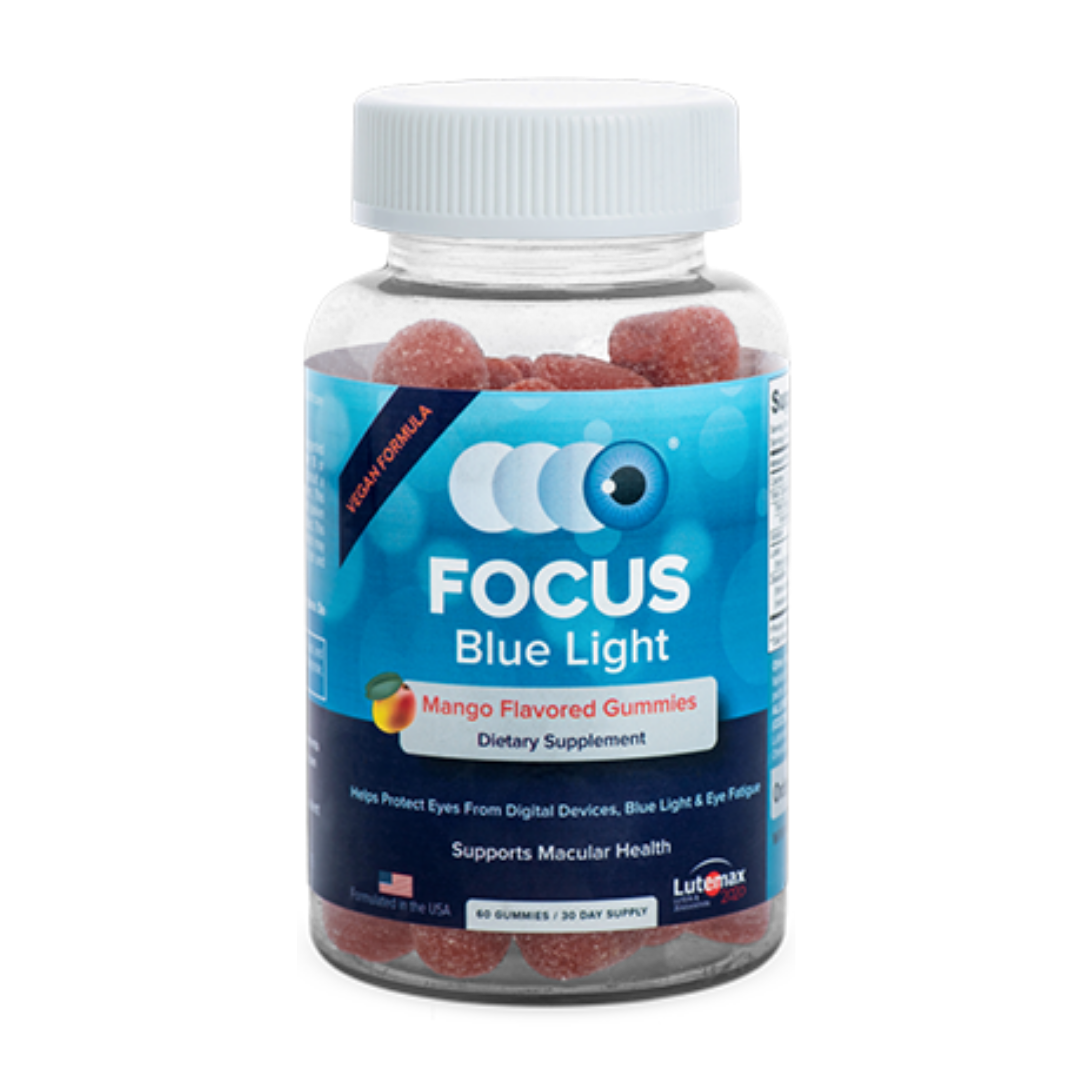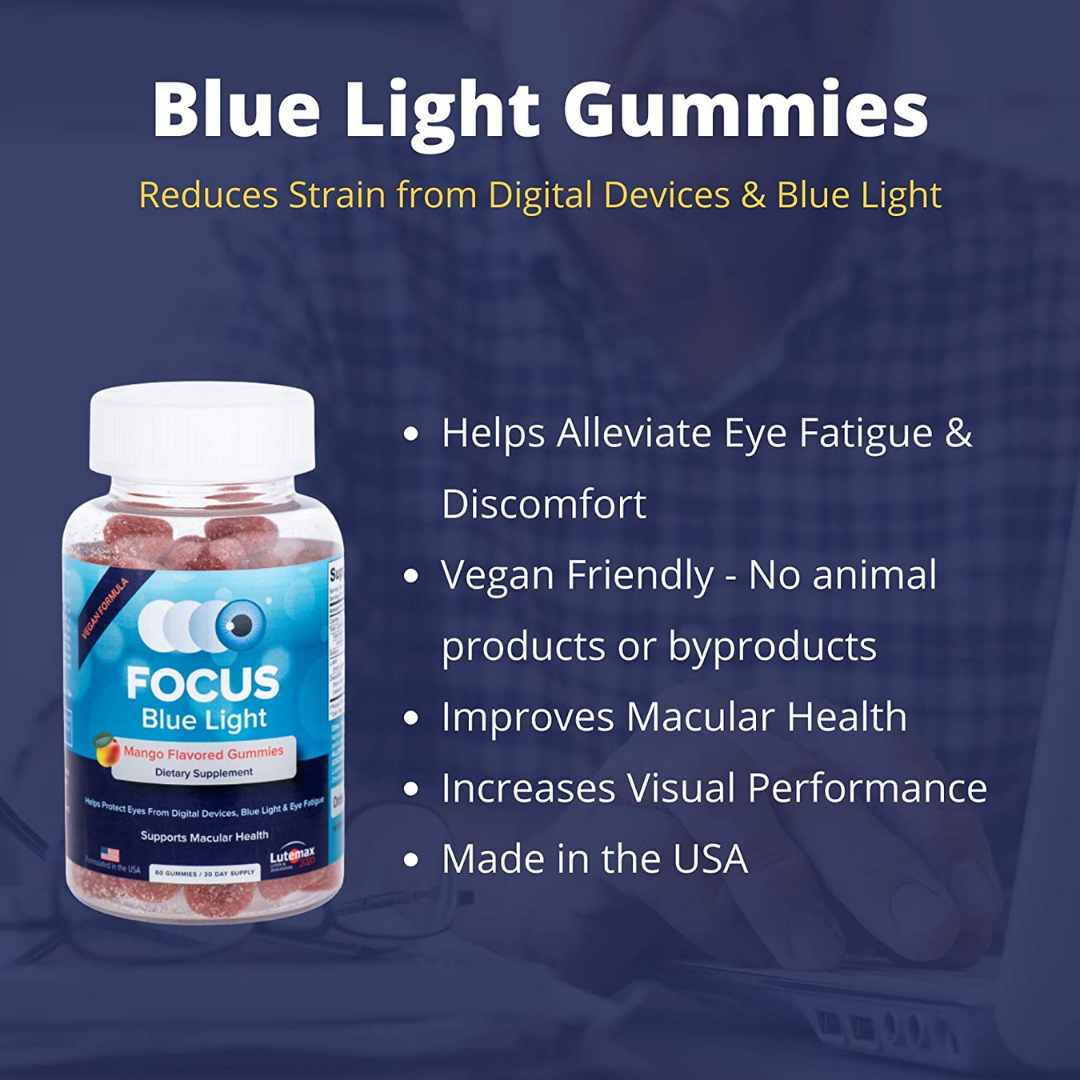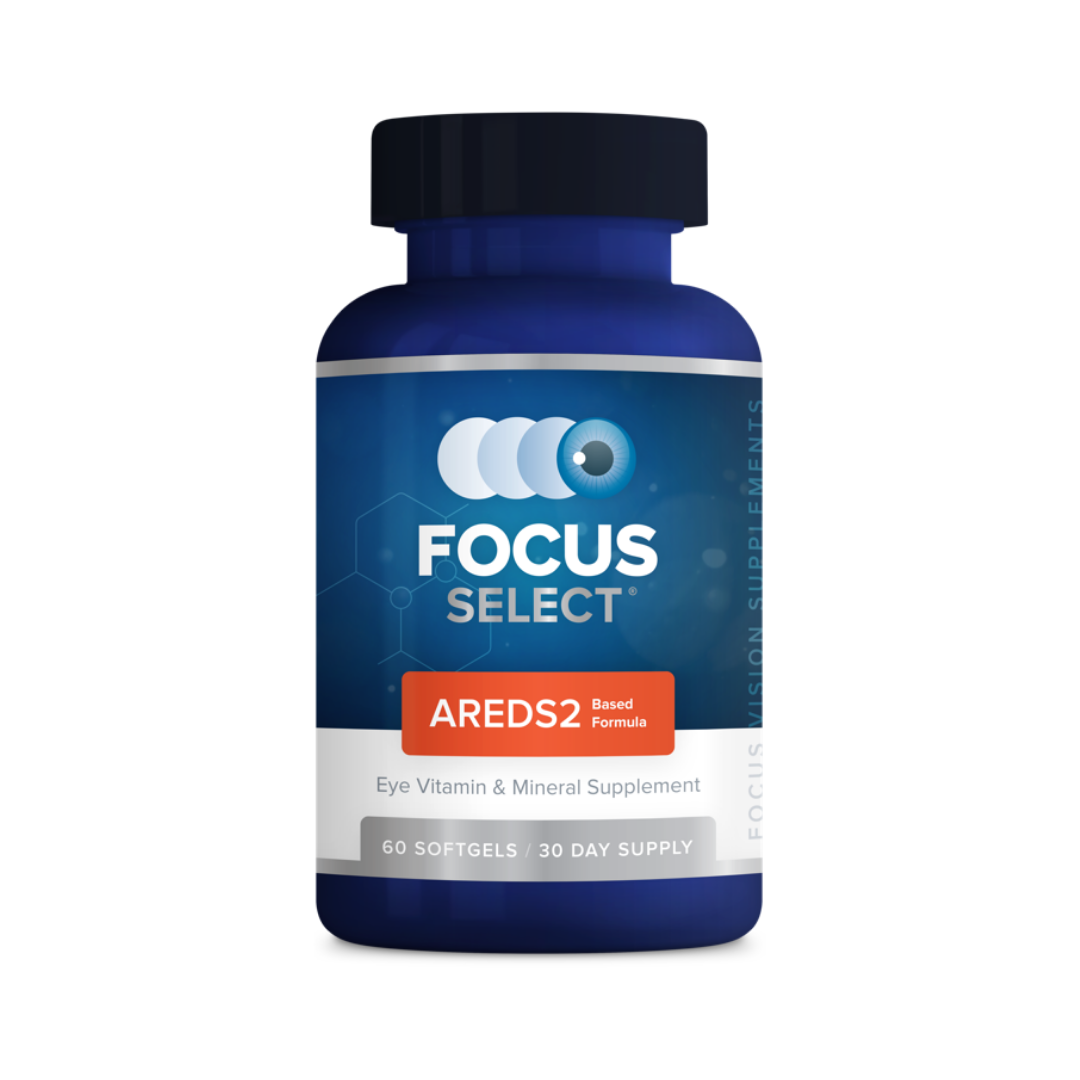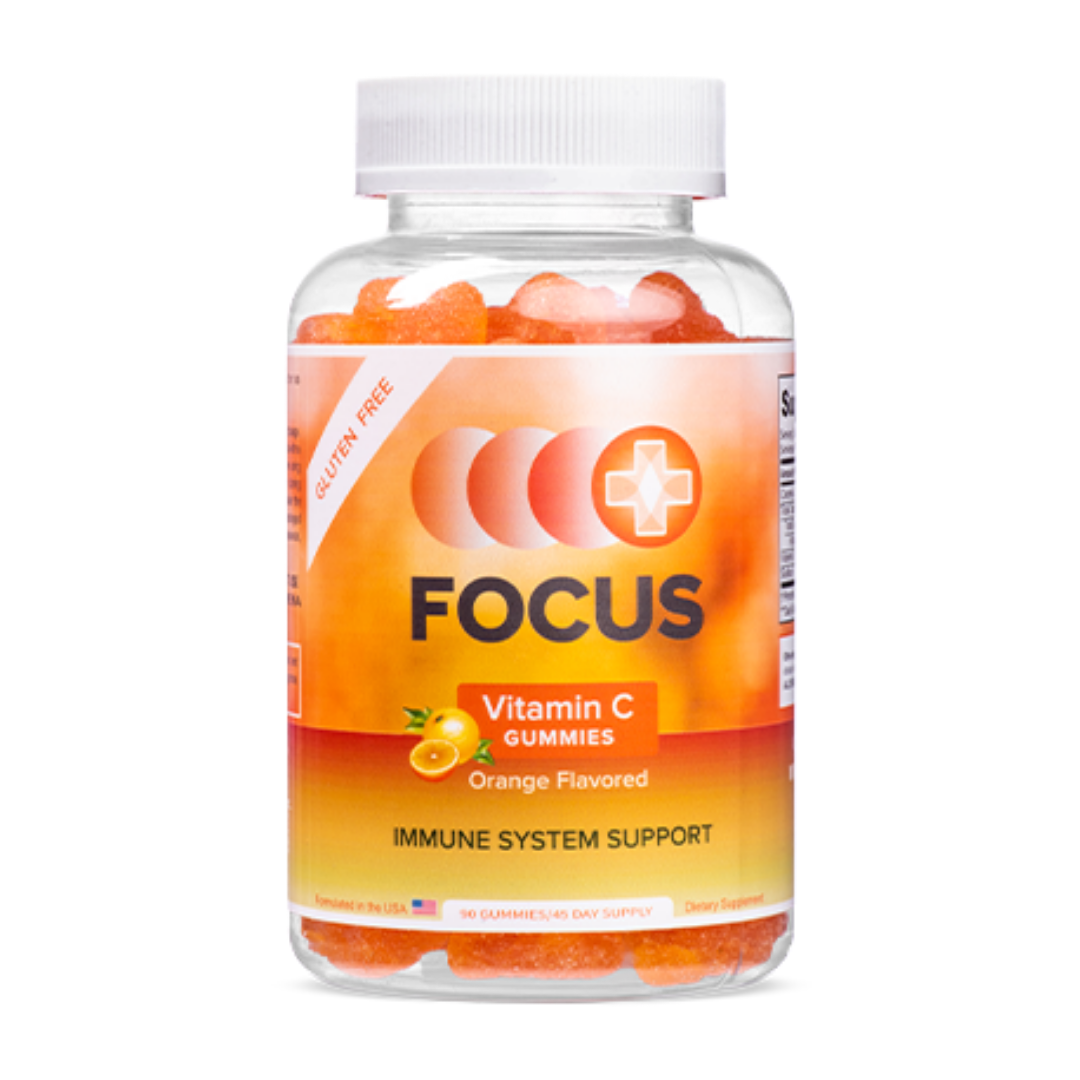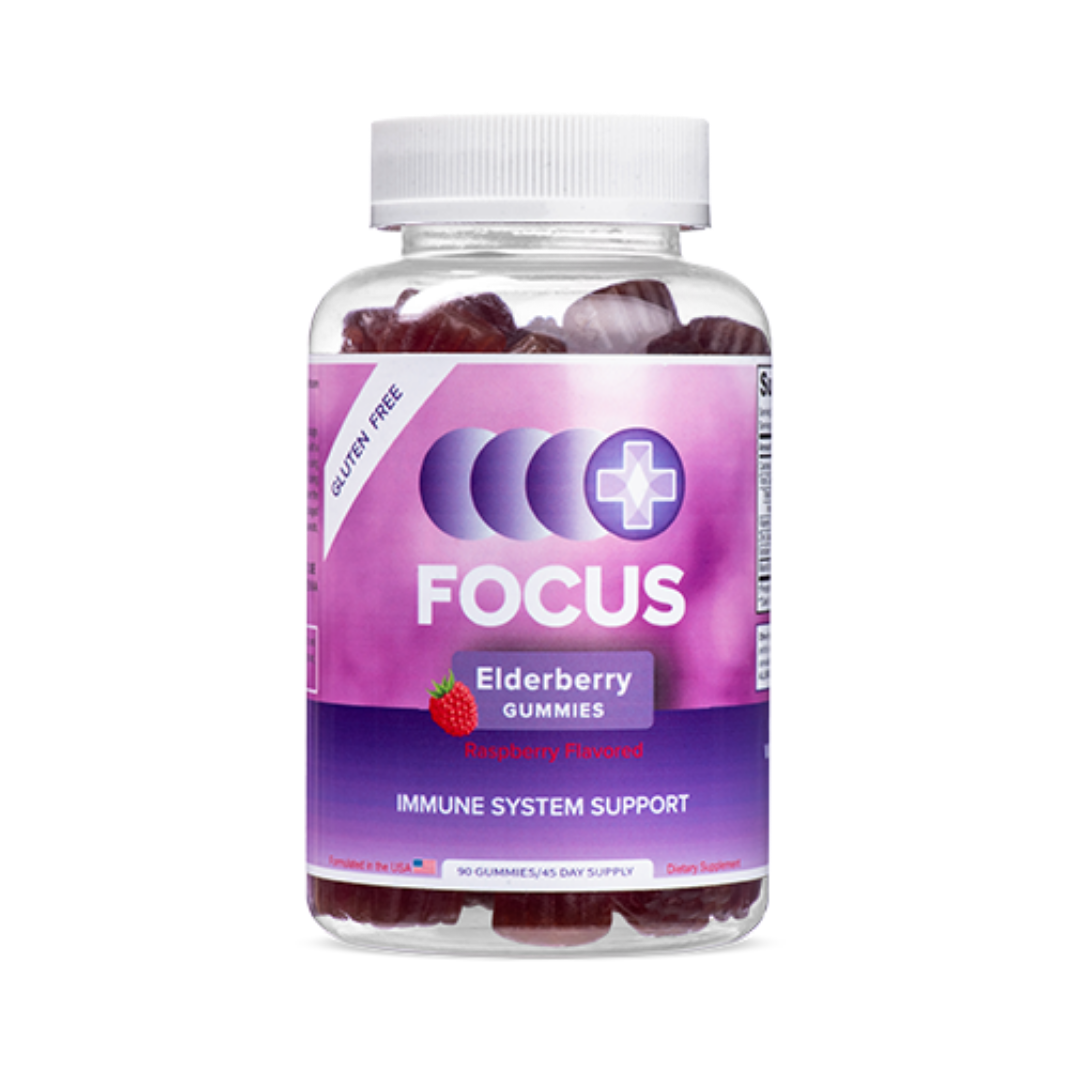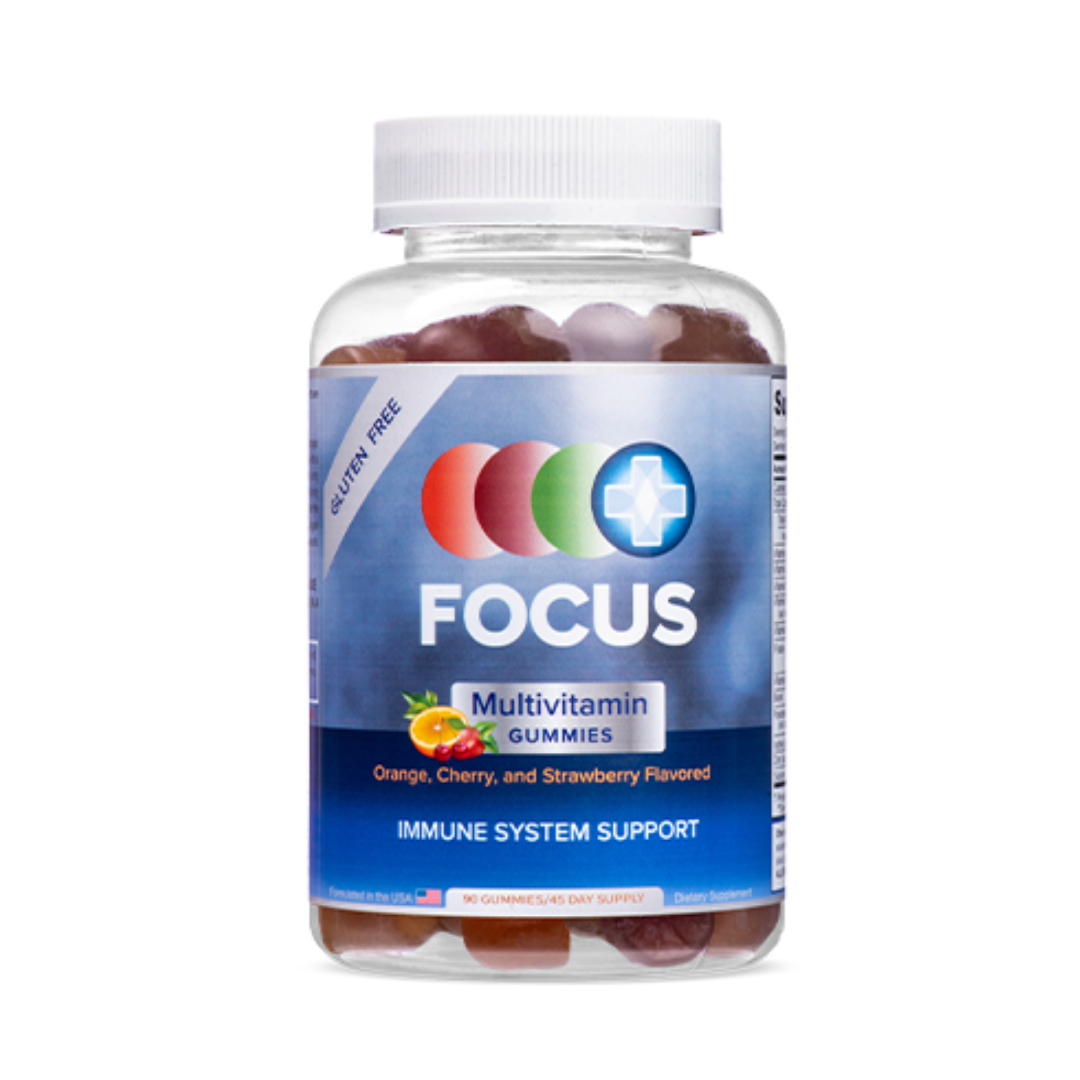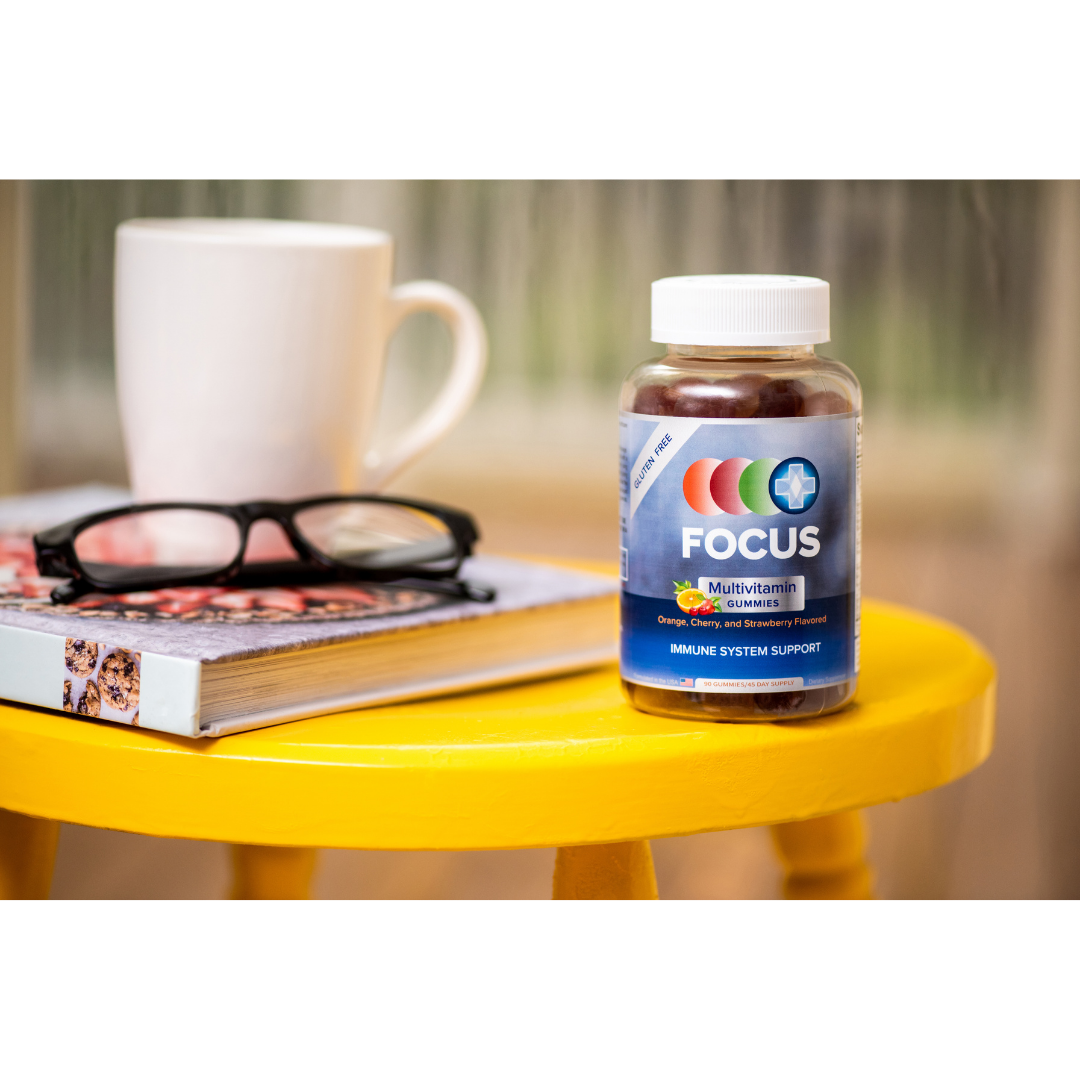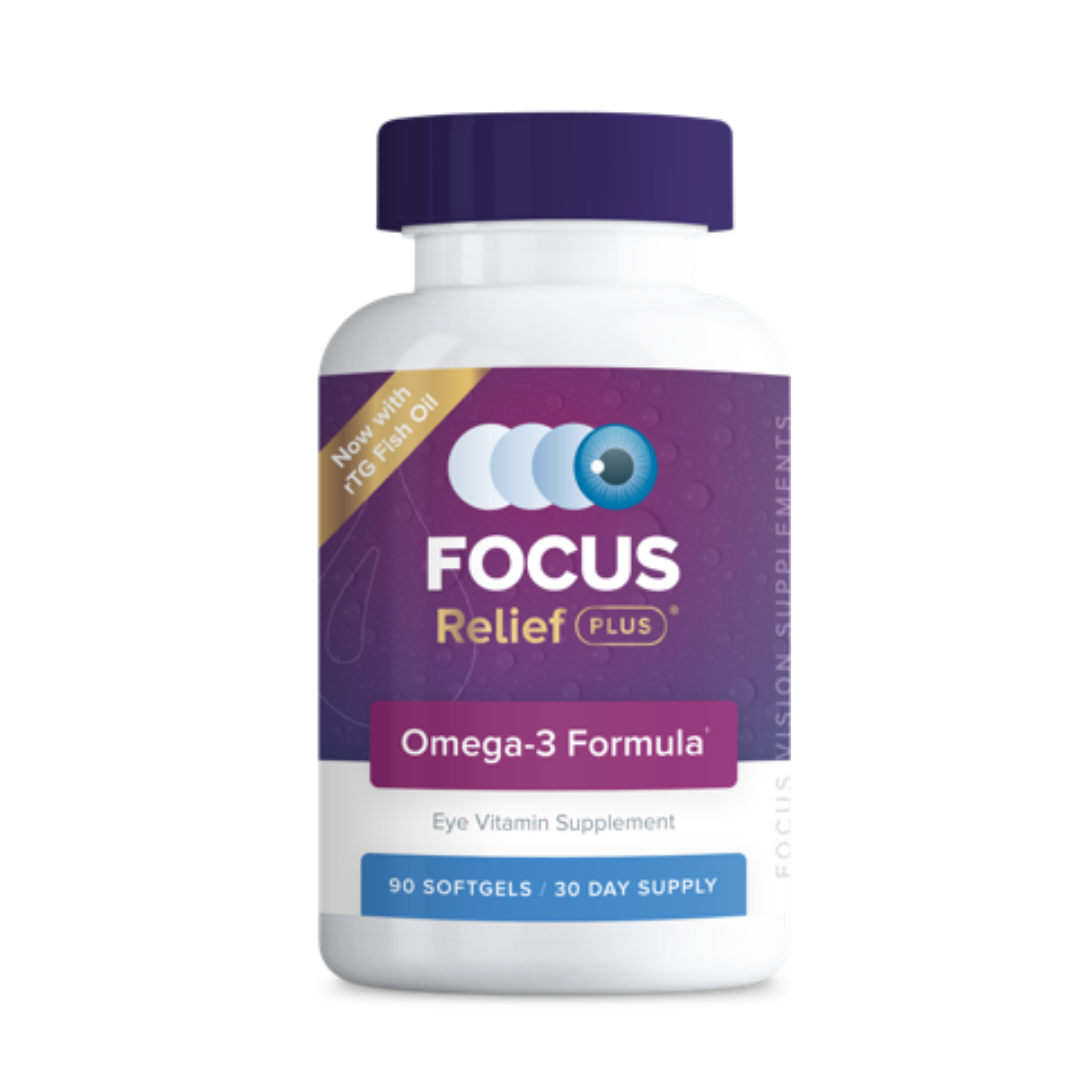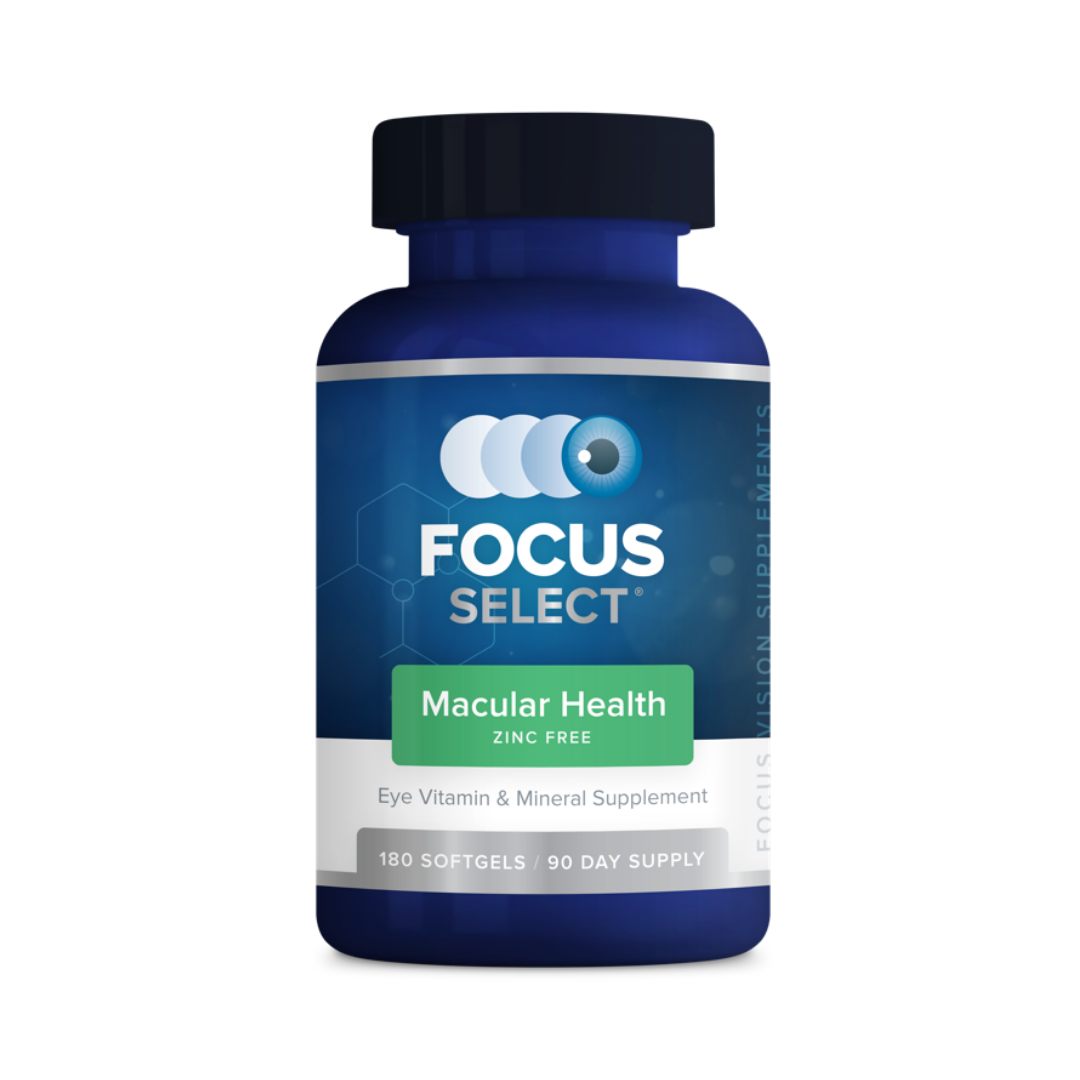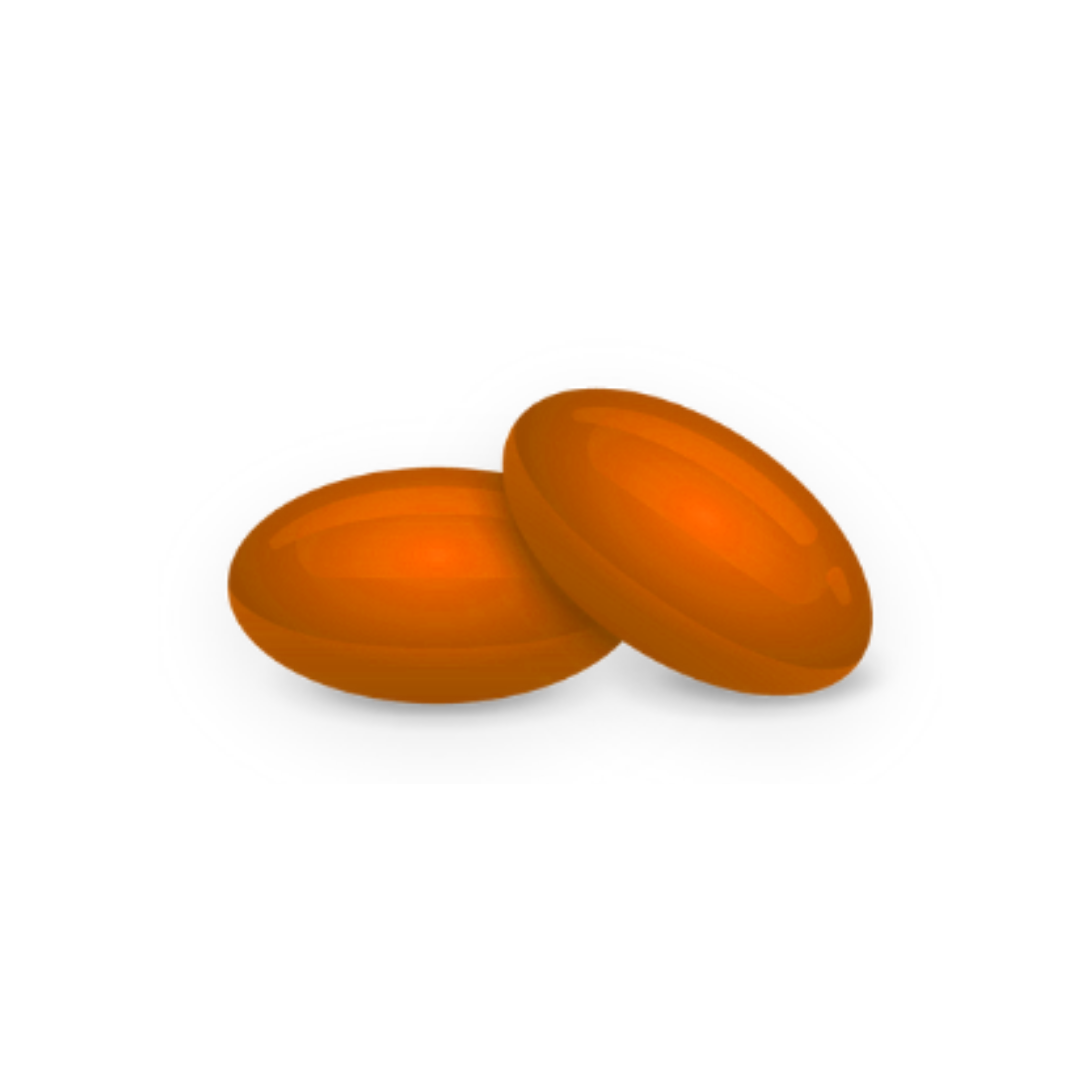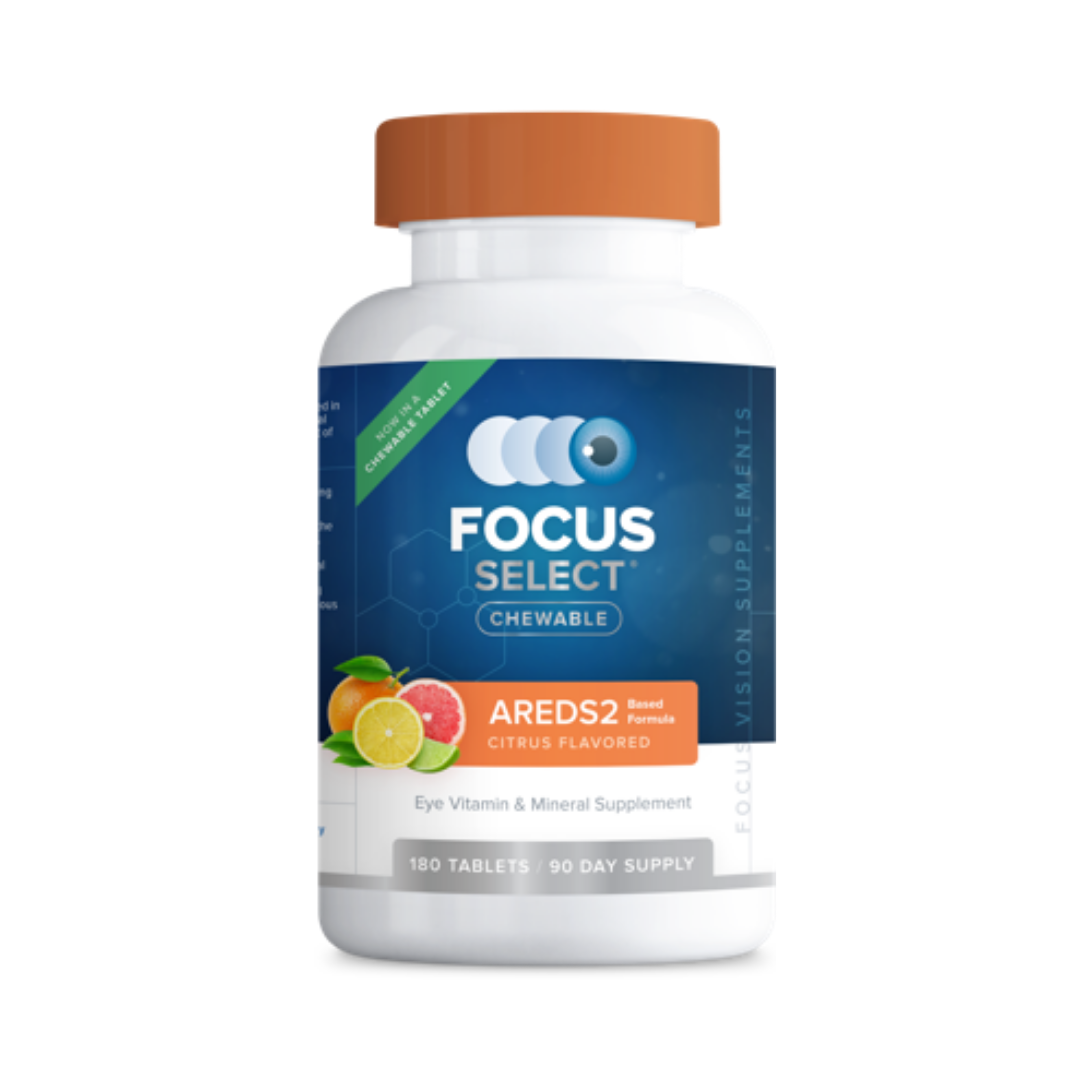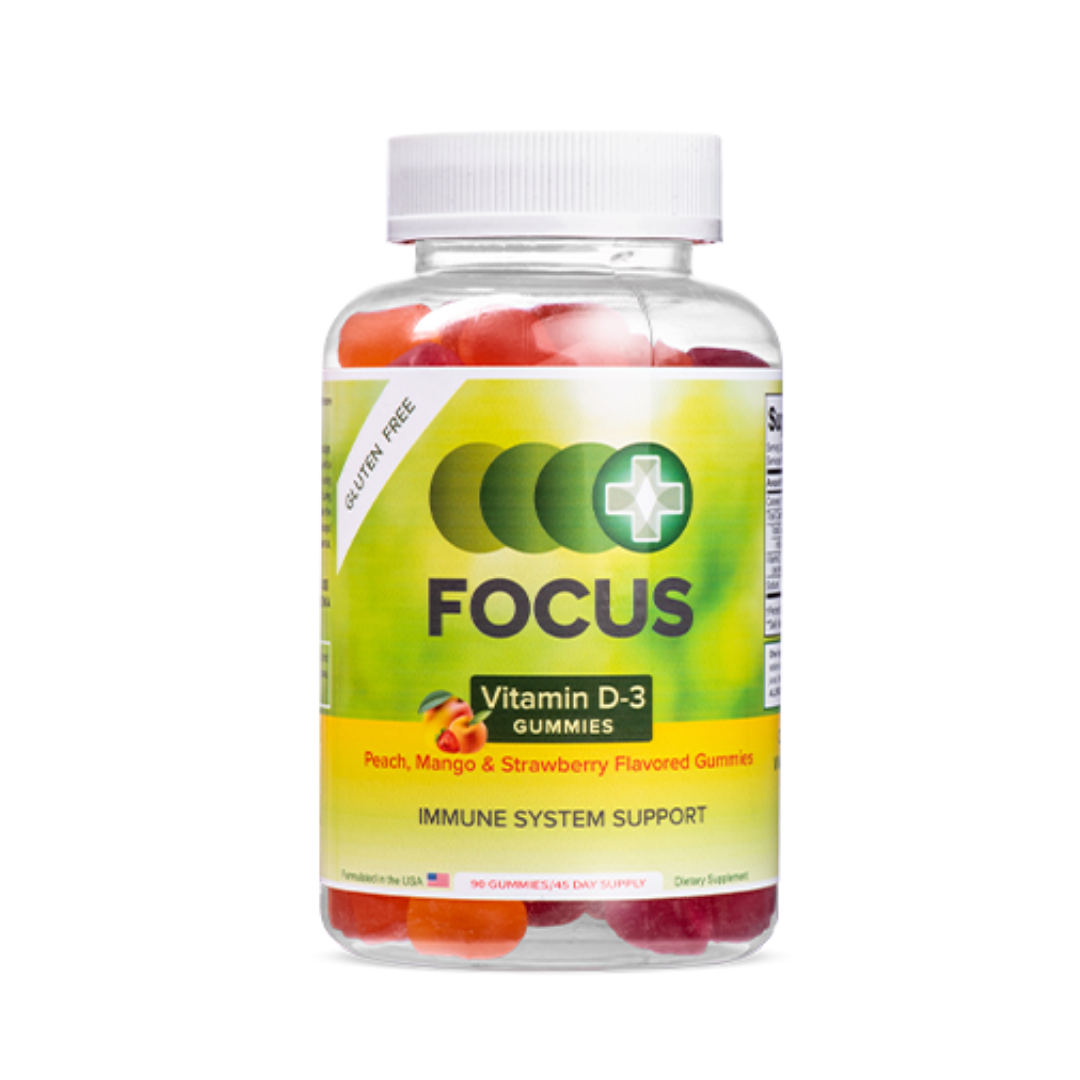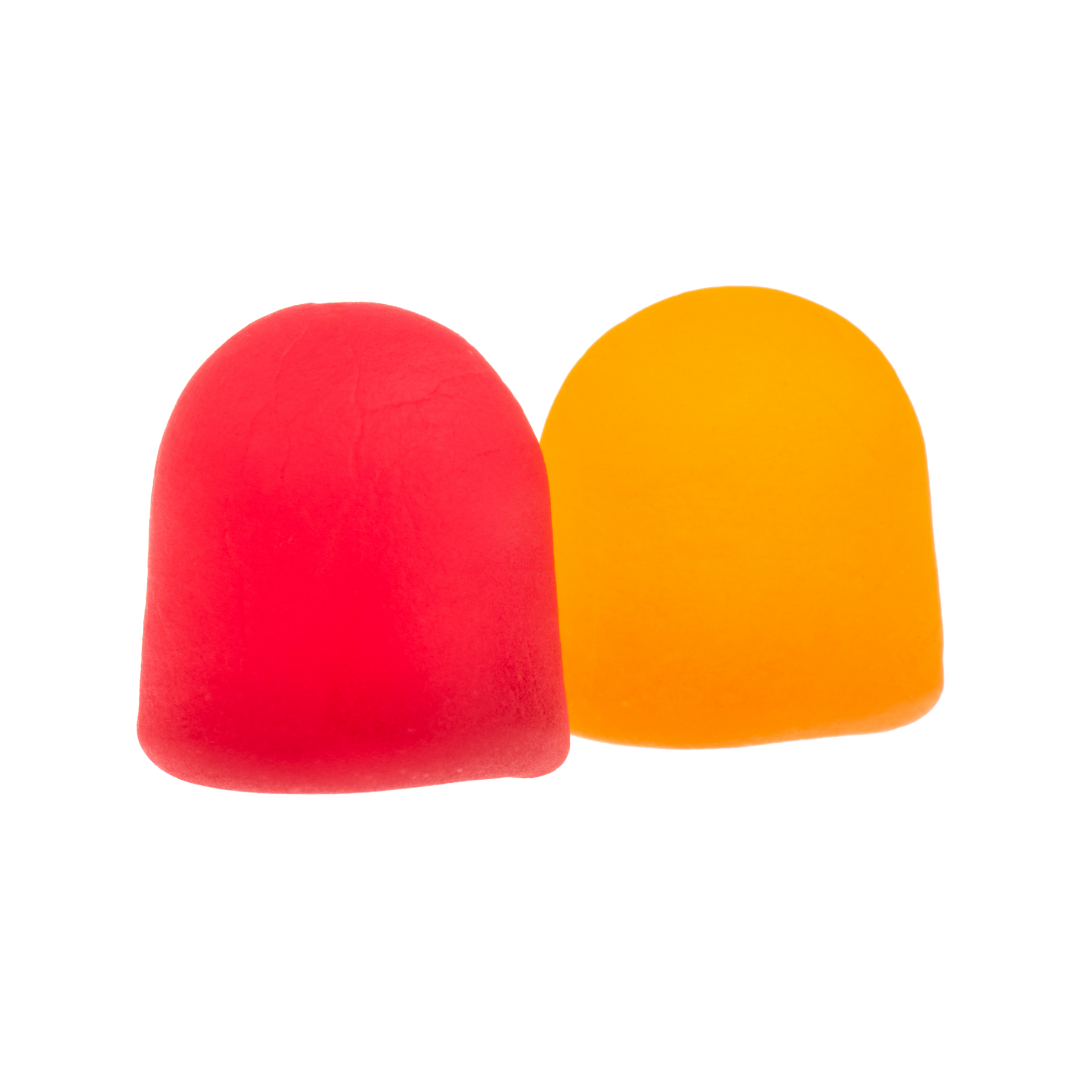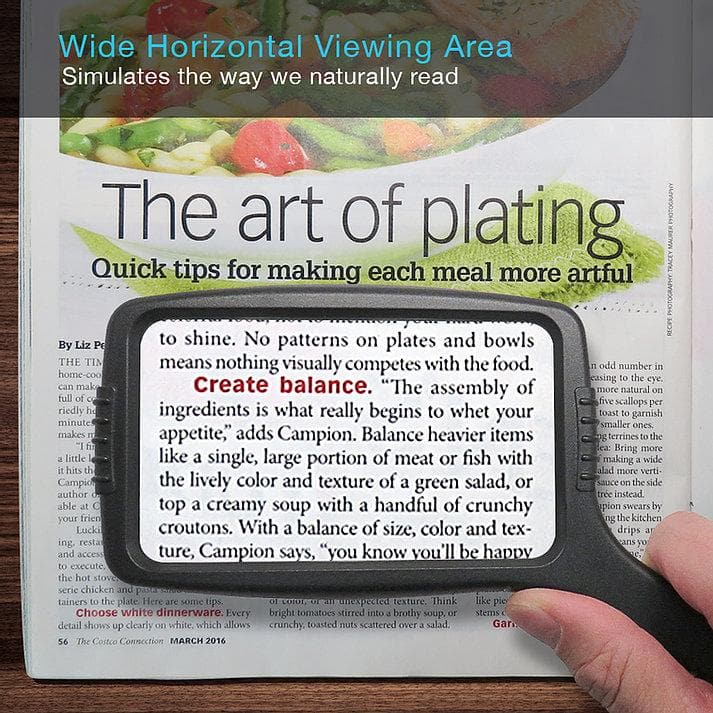Freedom Scientific Ruby HD Portable Low Vision Video Magnifier
Cataracts - What is a Cataract?
What is a cataract?
A cataract is a clouding of the lens in the eye that affects vision. Most cataracts are related to aging. Cataracts are very common in older people. By age 80, more than half of all Americans either have a cataract or have had cataract surgery.
A cataract can occur in either or both eyes. It cannot spread from one eye to the other.
What is the lens?
The lens is a clear part of the eye that helps to focus light, or an image, on the retina. The retina is the light-sensitive tissue at the back of the eye.
In a normal eye, light passes through the transparent lens to the retina. Once it reaches the retina, light is changed into nerve signals that are sent to the brain.
The lens must be clear for the retina to receive a sharp image. If the lens is cloudy from a cataract, the image you see will be blurred.
Are there other types of cataract
Yes. Although most cataracts are related to aging, there are other types of cataract:
- Secondary cataract. Cataracts can form after surgery for other eye problems, such as glaucoma. Cataracts also can develop in people who have other health problems, such as diabetes. Cataracts are sometimes linked to steroid use.
- Traumatic cataract. Cataracts can develop after an eye injury, sometimes years later.
- Congenital cataract. Some babies are born with cataracts or develop them in childhood, often in both eyes. These cataracts may be so small that they do not affect vision. If they do, the lenses may need to be removed.
- Radiation cataract. Cataracts can develop after exposure to some types of radiation.
Source & Credit - Enhanced Vision
National Eye Institute. Facts About Cataract
Diabetic Retinopathy - What is Diabetic Eye Disease?
What is diabetic eye disease?
Diabetic eye disease refers to a group of eye problems that people with diabetes may face as a complication of diabetes. All can cause severe vision loss or even blindness.
Diabetic eye disease may include:
- Diabetic retinopathy—damage to the blood vessels in the retina.
- Cataract—clouding of the eye’s lens. Cataracts develop at an earlier age in people with diabetes.
- Glaucoma—increase in fluid pressure inside the eye that leads to optic nerve damage and loss of vision. A person with diabetes is nearly twice as likely to get glaucoma as other adults.
What is diabetic retinopathy?
Diabetic retinopathy is the most common diabetic eye disease and a leading cause of blindness in American adults. It is caused by changes in the blood vessels of the retina.
In some people with diabetic retinopathy, blood vessels may swell and leak fluid. In other people, abnormal new blood vessels grow on the surface of the retina. The retina is the light-sensitive tissue at the back of the eye. A healthy retina is necessary for good vision.
If you have diabetic retinopathy, at first you may not notice changes to your vision. But over time, diabetic retinopathy can get worse and cause vision loss. Diabetic retinopathy usually affects both eyes.
What are the stages of diabetic retinopathy?
Diabetic retinopathy has four stages:
- Mild Nonproliferative Retinopathy. At this earliest stage, microaneurysms occur. They are small areas of balloon-like swelling in the retina’s tiny blood vessels.
- Moderate Nonproliferative Retinopathy. As the disease progresses, some blood vessels that nourish the retina are blocked.
- Severe Nonproliferative Retinopathy. Many more blood vessels are blocked, depriving several areas of the retina with their blood supply. These areas of the retina send signals to the body to grow new blood vessels for nourishment.
- Proliferative Retinopathy. At this advanced stage, the signals sent by the retina for nourishment trigger the growth of new blood vessels. This condition is called proliferative retinopathy. These new blood vessels are abnormal and fragile. They grow along the retina and along the surface of the clear, vitreous gel that fills the inside of the eye. By themselves, these blood vessels do not cause symptoms or vision loss. However, they have thin, fragile walls. If they leak blood, severe vision loss and even blindness can result.
Credit & Source - Enhanced Vision
National Eye Institute. Facts About Diabetic Retinopathy
Glaucoma - What is Glaucoma?
What is glaucoma?
Glaucoma is a group of diseases that can damage the eye’s optic nerve and result in vision loss and blindness. Glaucoma occurs when the normal fluid pressure inside the eyes slowly rises. However, with early treatment, you can often protect your eyes against serious vision loss.
What is the optic nerve?
The optic nerve is a bundle of more than 1 million nerve fibers. It connects the retina to the brain. (See diagram below.) The retina is the light-sensitive tissue at the back of the eye. A healthy optic nerve is necessary for good vision.
What are some other forms of glaucoma?
Open-angle glaucoma is the most common form. Some people have other types of the disease.
- Low-tension or normal-tension glaucoma. Optic nerve damage and narrowed side vision occur in people with normal eye pressure. Lowering eye pressure at least 30 percent through medicines slows the disease in some people. Glaucoma may worsen in others despite low pressures.
A comprehensive medical history is important in identifying other potential risk factors, such as low blood pressure, that contribute to low-tension glaucoma. If no risk factors are identified, the treatment options for low-tension glaucoma are the same as for open-angle glaucoma. - Angle-closure glaucoma. The fluid at the front of the eye cannot reach the angle and leave the eye. The angle gets blocked by part of the iris. People with this type of glaucoma have a sudden increase in eye pressure. Symptoms include severe pain and nausea, as well as redness of the eye and blurred vision. If you have these symptoms, you need to seek treatment immediately.
This is a medical emergency. If your doctor is unavailable, go to the nearest hospital or clinic. Without treatment to improve the flow of fluid, the eye can become blind in as few as one or two days. Usually, prompt laser surgery and medicines can clear the blockage and protect sight. - Congenital glaucoma. Children are born with a defect in the angle of the eye that slows the normal drainage of fluid. These children usually have obvious symptoms, such as cloudy eyes, sensitivity to light, and excessive tearing. Conventional surgery typically is the suggested treatment, because medicines may have unknown effects in infants and be difficult to administer. Surgery is safe and effective. If surgery is done promptly, these children usually have an excellent chance of having good vision.
- Secondary glaucomas. These can develop as complications of other medical conditions. These types of glaucomas are sometimes associated with eye surgery or advanced cataracts, eye injuries, certain eye tumors, or uveitis (eye inflammation). Pigmentary glaucoma occurs when pigment from the iris flakes off and blocks the meshwork, slowing fluid drainage. A severe form, called neovascular glaucoma, is linked to diabetes. Corticosteroid drugs used to treat eye inflammations and other diseases can trigger glaucoma in some people. Treatment includes medicines, laser surgery, or conventional surgery.
Source & Credit - Enhanced Vision
National Eye Institute. Facts About Glaucoma.
Macular Degeneration - What Is It?
What is Macular Degeneration
Age Related Macular Degeneration is a degenerative disease of the retina that causes progressive loss of vision in the center of the eye. People describe it as having a spot or blurry space in the middle of their vision that interferes with daily tasks like reading and driving. There are two types of macular degeneration, dry and wet.
Dry Age Related Macular Degeneration results when yellow-white deposits called drusen accumulate under the macula, which is the central portion of the retina. Scientists don’t know exactly why this occurs.
In Wet Age Related Macular Degeneration, abnormal blood vessel growth forms under the macula and leaks fluid damaging photoreceptor cells. Wet Age Related Macular Degeneration can progress rapidly and cause serious damage. If it’s caught early, however, laser surgery may be able to prevent extensive vision loss.
The risk of developing macular degeneration increases with age and the disease is the most common cause of vision loss in people over the age of 55, particularly women. While it significantly reduces vision, Age Related Macular Degeneration does not cause total blindness.
If you have suffered vision loss due to Age Related Macular Degeneration your doctor will probably refer you to a low vision specialist. This dedicated eye care professional will be able to evaluate your available vision and refer you to other specialists who can assist with rehabilitation and resources.
To learn more about vision rehabilitation please read our article called: “Vision Rehabilitation is the Key”.
Most of all, realize that you are not alone. Millions of Americans experience low vision through various eye diseases, like Macular Degeneration, and there are many organizations, professionals and resources available to you. In addition to these resources there are products, like digital magnification, which allow you to maintain your independence through the vision loss process.
Source & Credit - Enhanced Vision
Vision Aid User Manuals
Below you will find links to download the different User Manuals for the Vispero family of brands which include Optelec, Enhanced Vision and Freedom Scientific. Click the specific product to download the user manuals.
Enhanced Vision User Manuals
- Acrobat HD Ultra LCD
- Acrobat HD ultra Long & Short Arm
- Acrobat HD-mini ultra
- Amigo HD User Manual
- Amigo HD Quick Start Guide
- DaVinci HD/OCR
- DaVinci Pro HD/OCR User Manual
- DaVinci Pro HD/OCR Quick Start Guide
- Jordy User Manual
- Merlin Elite User Manual
- Merlin Elite Pro User Manual
- Merlin HD User Manual
- Merlin LCD User Manual
- Merlin LCD Plus User Manual
- Merlin Ultra User Manual
- Merlin Basic User Manual
- Pebble HD User Manual
- Pebble HD Quick Start User Guide
- Smart Reader HD User Manual
- Transformer HD User Manual
- USB Bridge User Manual
Freedom Scientific User Manuals
Handheld Video Magnifiers
Desktop Video Magnifiers
Portable Video Magnifiers
- omniReader Portable Scanner and Reader (PDF)
- ONYX® Family of Portable Magnifiers
- TOPAZ Ultra Portable Magnifier (PDF)
- TOPAZ PHD Portable Magnifier
- PEARL® Portable Reading Camera (PDF)
- GEM Software
Scanning and Reading Solutions
- OpenBook® and PEARL® Scanning & Reading Solution (PDF)
- SARA™ CE Scanning & Reading Hardware
- SARA Scanning & Reading Hardware (PDF)
- Eye-Pal® Ace Plus (PDF)
- Eye-Pal Ace (PDF)
- Eye-Pal ROL (PDF)
- Eye-Pal Ace / Eye-Pal Ace Plus / Eye-Pal ROL Placement Guide (PDF)
- Eye-Pal SOLO™ User Guide (PDF)
- Eye-Pal Reader
- Eye-Pal Vision
- Eye-Pal User Guide (PDF)
- Eye-Pal Quick Reference Guide (PDF)
- Zoom-Office® for Windows User Guide (PDF)
- Zoom-Office for Mac User Guide (PDF)
- Product opens in a new tab.
The Freedom Scientific Ruby HD Portable Low Vision Video Magnifier brings you crystal-clear images and advanced features in a compact, lightweight body with a 4.3-inch screen. Features include 20 high-contrast color modes, Reading Lines and Masks, Freeze Frame, and the ability to store and transfer images.
The RUBY HD combines high-definition camera technology with a lightweight body to bring you crystal-clear images in a small package. The 4.3-inch screen and built-in LED lighting provide magnified high-contrast images with no distortion. Its streamlined design means it can slip comfortably into a pocket or purse, giving you easy access to photos, prescription labels, and much more. The RUBY HD is easy to use and has advanced features that can make you even more independent.
The RUBY HD is available in two models:
- RUBY HD is offered in traditional red with color buttons.
-
RUBY HD+ is offered in gray with high-contrast, black and white buttons.
Features:
- View text and images on the 4.3-inch LCD
- Continuous zoom with 2x–13x magnification
- Lightweight design at only 8 ounces
- Fast reading with no blur
- Easy flip-out handle
- Uses rechargeable or disposable AAA batteries
- Goes anywhere with 2 hours continuous use
Advanced Features:
- Freeze Frame with adjustable magnification
- Adjustable Reading Line and Masks to keep your place
- 20 high-contrast color viewing modes so you can adjust text to be easy on your eyes
- Save images and send to computer with USB port
- Slide Show mode for hands-free review
- Includes batteries, charger, wrist strap, case, and USB cable
- Optional reading stand
Documents
- Reviews
- Questions
What is Macular Degeneration
Age Related Macular Degeneration is a degenerative disease of the retina that causes progressive loss of vision in the center of the eye. People describe it as having a spot or blurry space in the middle of their vision that interferes with daily tasks like reading and driving. There are two types of macular degeneration, dry and wet.
Dry Age Related Macular Degeneration results when yellow-white deposits called drusen accumulate under the macula, which is the central portion of the retina. Scientists don’t know exactly why this occurs.
In Wet Age Related Macular Degeneration, abnormal blood vessel growth forms under the macula and leaks fluid damaging photoreceptor cells. Wet Age Related Macular Degeneration can progress rapidly and cause serious damage. If it’s caught early, however, laser surgery may be able to prevent extensive vision loss.
The risk of developing macular degeneration increases with age and the disease is the most common cause of vision loss in people over the age of 55, particularly women. While it significantly reduces vision, Age Related Macular Degeneration does not cause total blindness.
If you have suffered vision loss due to Age Related Macular Degeneration your doctor will probably refer you to a low vision specialist. This dedicated eye care professional will be able to evaluate your available vision and refer you to other specialists who can assist with rehabilitation and resources.
To learn more about vision rehabilitation please read our article called: “Vision Rehabilitation is the Key”.
Most of all, realize that you are not alone. Millions of Americans experience low vision through various eye diseases, like Macular Degeneration, and there are many organizations, professionals and resources available to you. In addition to these resources there are products, like digital magnification, which allow you to maintain your independence through the vision loss process.
Source & Credit - Enhanced Vision
What is a cataract?
A cataract is a clouding of the lens in the eye that affects vision. Most cataracts are related to aging. Cataracts are very common in older people. By age 80, more than half of all Americans either have a cataract or have had cataract surgery.
A cataract can occur in either or both eyes. It cannot spread from one eye to the other.
What is the lens?
The lens is a clear part of the eye that helps to focus light, or an image, on the retina. The retina is the light-sensitive tissue at the back of the eye.
In a normal eye, light passes through the transparent lens to the retina. Once it reaches the retina, light is changed into nerve signals that are sent to the brain.
The lens must be clear for the retina to receive a sharp image. If the lens is cloudy from a cataract, the image you see will be blurred.
Are there other types of cataract
Yes. Although most cataracts are related to aging, there are other types of cataract:
- Secondary cataract. Cataracts can form after surgery for other eye problems, such as glaucoma. Cataracts also can develop in people who have other health problems, such as diabetes. Cataracts are sometimes linked to steroid use.
- Traumatic cataract. Cataracts can develop after an eye injury, sometimes years later.
- Congenital cataract. Some babies are born with cataracts or develop them in childhood, often in both eyes. These cataracts may be so small that they do not affect vision. If they do, the lenses may need to be removed.
- Radiation cataract. Cataracts can develop after exposure to some types of radiation.
Source & Credit - Enhanced Vision
National Eye Institute. Facts About Cataract
Helpful Articles
-
Read more
Glasses don't address every vision need, especially for patients diagnosed with macular degeneration, diabetic retinopathy, glaucoma or a similar condition. Here is where low vision aids come in: These devices including handheld magnifiers, portable and desktop video magnifiers and other...

